FOURTEEN FROG FRIDAY
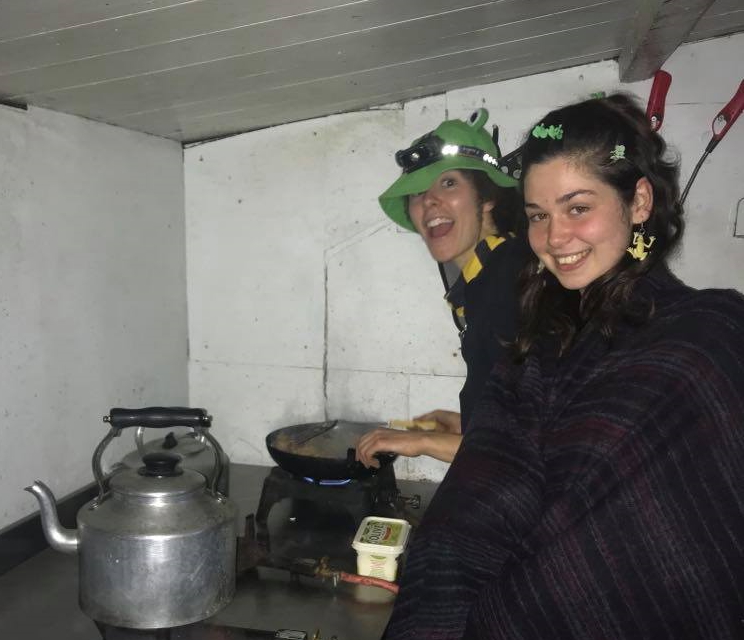
Merryn (left), Mia (right) and their froggy friends. Count the frogs in this photo and the next one and you might get a prize!
Frogs make an unexpected appearance at the Hut and Mia Jacobs reports on her first time doing the Swildon's Short Round Trip.
On Friday 28th May, Ash, Merryn and I warmed up for our short
round trip by spending a night at the hut. We had a relaxed dinner of
spag bol, cake, and beer, and began to calm down at a sensible time when
our party was crashed by Henry and a couple of Cambridge cavers, who
were stopping off on their way to South Wales.
After our surprise reunion we actually went to sleep and went our
separate ways the next morning. Jakob joined us and we headed to Priddy
to begin the adventure – we found a blackbird's nest in the changing
barn! We have no caving photos so, instead, I offer you Frog Friday.
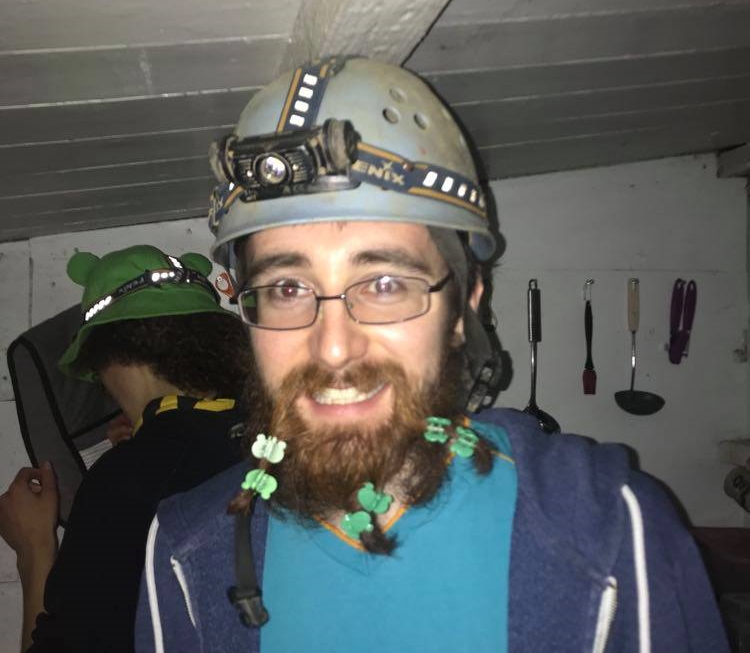
Ash and even more frogs! Can you perform a frog count?
It was my and Jakob’s first time tackling
the Swildon’s short round, and it took us about three and a half hours
overall. Everybody made their way quite seamlessly through the cave with
me making sure to slow the pace on climbs and traverses. We tackled the
Troubles efficiently, despite my drifting up a choked tube in one of
the ducks and getting more stuck and colder than strictly necessary.
Jakob and I also dived our first sump (Sump 1) with great success, which
was a proud moment!
Our trip also served as a perfect case study for wet cave clothing, with
Jakob on one end of the spectrum wearing a furry, myself and Merryn on
the other with full wetsuits, and Ash in the middle with a neofleece.
My wetsuit, which feels a little smaller than when I took it on expo in
September, acted as a whole-body resistance band, making my arms very
tired towards the end (I had to take a break during the ladder climb on
the 20!) but did keep me toasty, while Jakob, on the other hand, had
ease of movement the whole trip but got rather cold towards the end. We
have now been convinced of the necessity of a neofleece.
Mia Jacobs
|
|
TWO FOR THE PRICE OF ONE
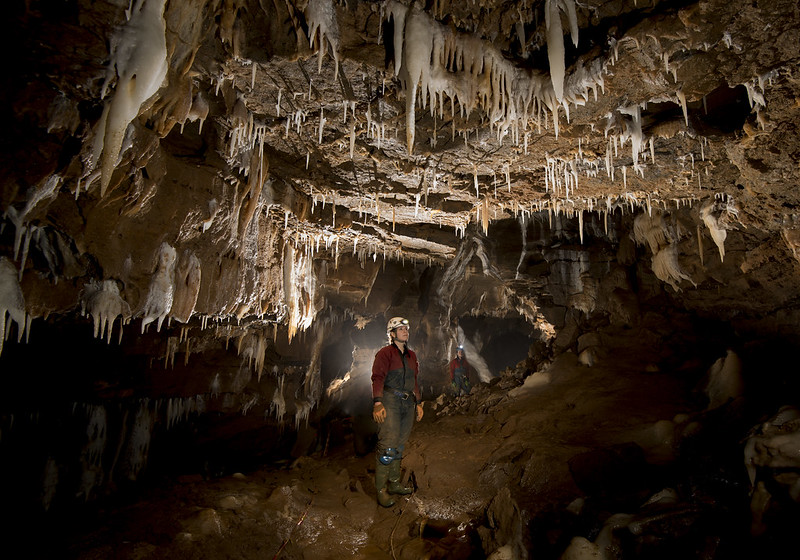
GB Bat Passage. Photo copyright Mark Burkey and used with his kind permission.
As an unexpected bonus, we received
two reports of the same trip, one from Megan and the other from Imogen,
and never ones to bench material, we're letting you all play spot the
difference with these two re-tellings of a GB trip in which one
participant left behind an important item of kit .... no, for once it
wasn't the key!
NO MAN LEFT BEHIND (EXCEPT SAM)
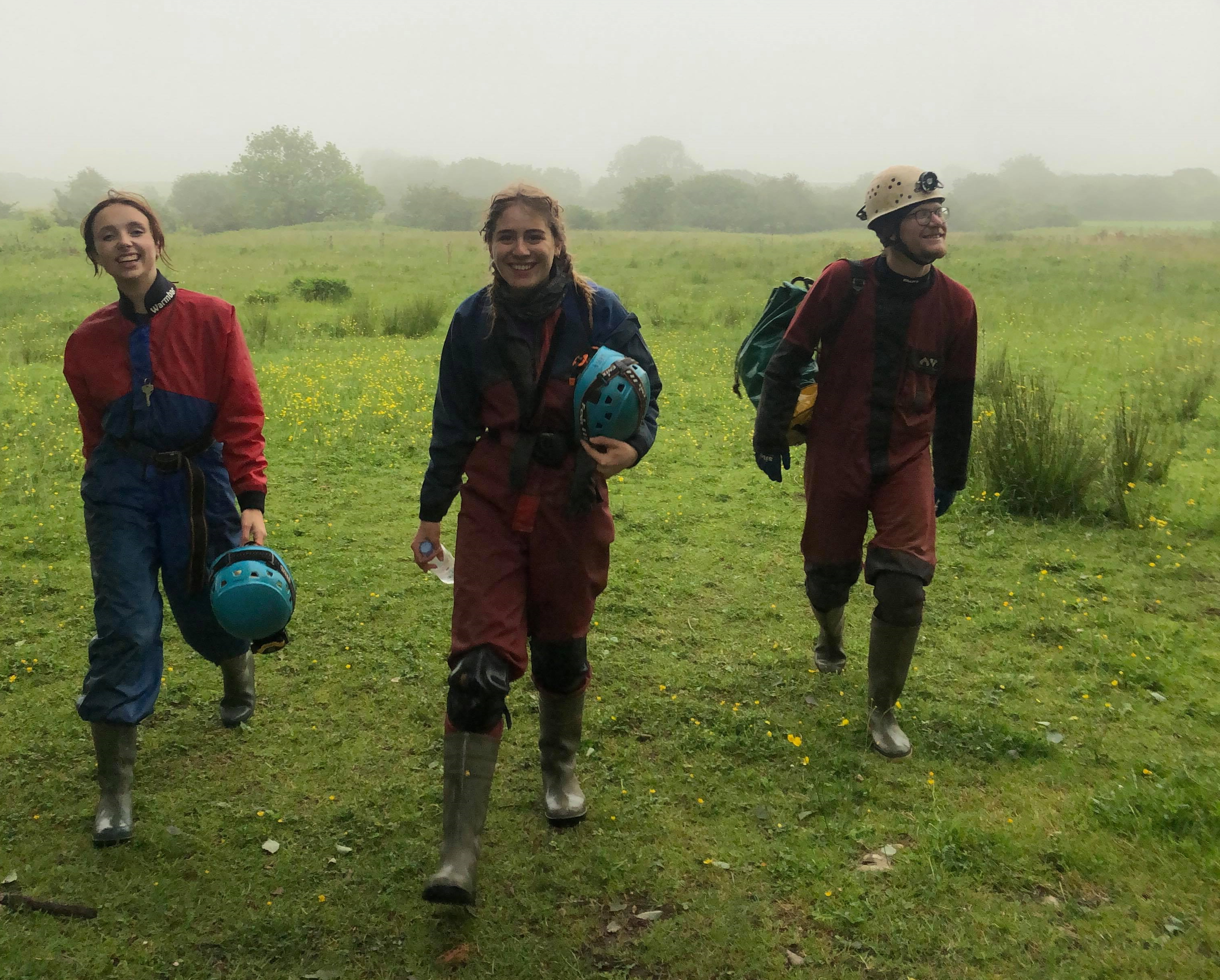
Our intrepid explorers returning from the cave. Left to right: Megan, Imogen and Jakob.
Having had a couple of weeks to adjust to
our post-exams lives of leisure, Sam, Imogen, Jakob and I decided to set
off on a purely recreational trip down GB on June 20th. It had been a
while since I’d been caving purely for fun, without the additional goals
of taking freshers or surveying, and I’d half forgotten that it was
possible.
After we arrived, Sam opened his bag and discovered that he’d only
brought one welly. Imogen drove him to Charterhouse in an attempt to
source some borrowable wellies, but unfortunately had no success. We
left him wandering amongst the fields and ponies as the remaining three
of us went underground.
The trip was reasonably straightforward. We avoided the recent rock fall
in Main Chamber by looping upwards and made our way up the ladder and
through the duck, finally ending up in Great Chamber. Jakob did most of
the wayfinding, and I helped by waiting for him to point out the right
way and then confidently stating that he was correct.
Three hours later, we emerged from the cave to find the fields covered
in mist and Sam wandering the land like a lost spirit, his phone battery
having run dry an hour and a half earlier. Sam, Imogen and I ended the
night with three Dominoes pizzas and the underwhelming final Fifty
Shades movie. All in all, it was a mostly successful recreational trip,
and helped me feel like less of an imposter when I tell people that
caving is my hobby.
Megan Malpas
A FRIGHT IN THE FOG
Eager to escape the overcast June afternoon
outside, Sam Bowers and myself decided to take a spontaneous trip down
GB. Having not been in since before the pandemic, we recruited Megan
Malpas and Jakob Annerdal for their more recent knowledge (and Jakob’s
laminated survey).
After a quick pitstop to pick up a ladder we drove over the Mendip hills
towards the cave. Upon arriving, we got dressed. Sam then realised he
only had one welly. Following some quick thinking (on my behalf) Sam and
I got back into the car and drove up to the Charterhouse Outdoor
Centre. Despite a nice conversation with an outdoor instructor who was
slightly bemused at the sight of Sam in a rainbow onesie, his supervisor
refused to lend Sam a welly. Sam’s shoes were particularly
unsuitable: white, with zero grip. So it was just me, Megan, and Jakob
in the cave.
The cave was good fun. I tested out my new Fenix - unbeknownst to me, it
was on one of the highest settings and on the way out it went into a
slightly-less-good battery saving mode. Might charge it before next time. Other than that, it was a good first trip for the light!
We went through the White Passage loop to avoid the rockfall, which was
still good fun – lots of pretties. Then up the ladder and then on to the
Great Chamber, which looked extra good with my still-yet-to-go-dim
brand-new head torch. Feeling a bit sorry for Sam surely going a bit
insane in my lime green Fiesta, we decided to give the Bat Passage a
miss for another day and headed out. The cave was finally catching up to
the weather outside, and what had been pretty bone-dry on the way in
was now trickling with water. What I could see, anyway, with my rapidly
dimming light.
Out of the cave we met up with Sam and he recounted his day of not-caving.
Interlude: Sam Bowers' Day Off
Whilst my comrades Imogen, Megan and Jakob were off gallivanting down GB
I was left behind in the car for what I thought would be an
uninteresting three hour wait, however I was gravely mistaken. Having
had a surprisingly pleasant 90-minute conversation with my mother, that
involved me whining about England’s dismal performance against Scotland
the previous Friday and her moaning about how my neighbour still had not
taken his garden waste to the tip, I sat thinking of something to do
that could pass the time.
Finally, I decided a walk on the moorland surrounding GB would be
relaxing (how wrong I was) and set off on my merry way equipped only
with a crunchie bar. Within minutes I found myself surrounded by fog and
slightly lost - this is when the hallucinations started!
I heard a voice that sounded very much like Jakob’s cry out for help
that sent me into a panic and caused me to rush towards the entrance to
GB only to find one of Mendip’s many wild horses blocking my path. After
a lengthy standoff involving much snorting and pounding of feet from
both myself and the horse, I eventually became brave enough to back away
and make a dash for the car where I waited nervously for the return of
my friends. When they returned, I asked about the shout I had heard, and
their bemused reaction sent a shiver down my spine.
If it had not been Jakob, who else had been out there with me on that foggy Mendip moor?
End of Interlude
All in all – a good day of caving (or meeting suspicious horses) and
back to Bristol for a shower, a takeout pizza, and a nice cold white
claw. Not my typical post-cave pint, but surprisingly delicious and
refreshing.
Imogen Clement and Sam Bowers
|
|
THREE FOR THE PRICE OF ONE
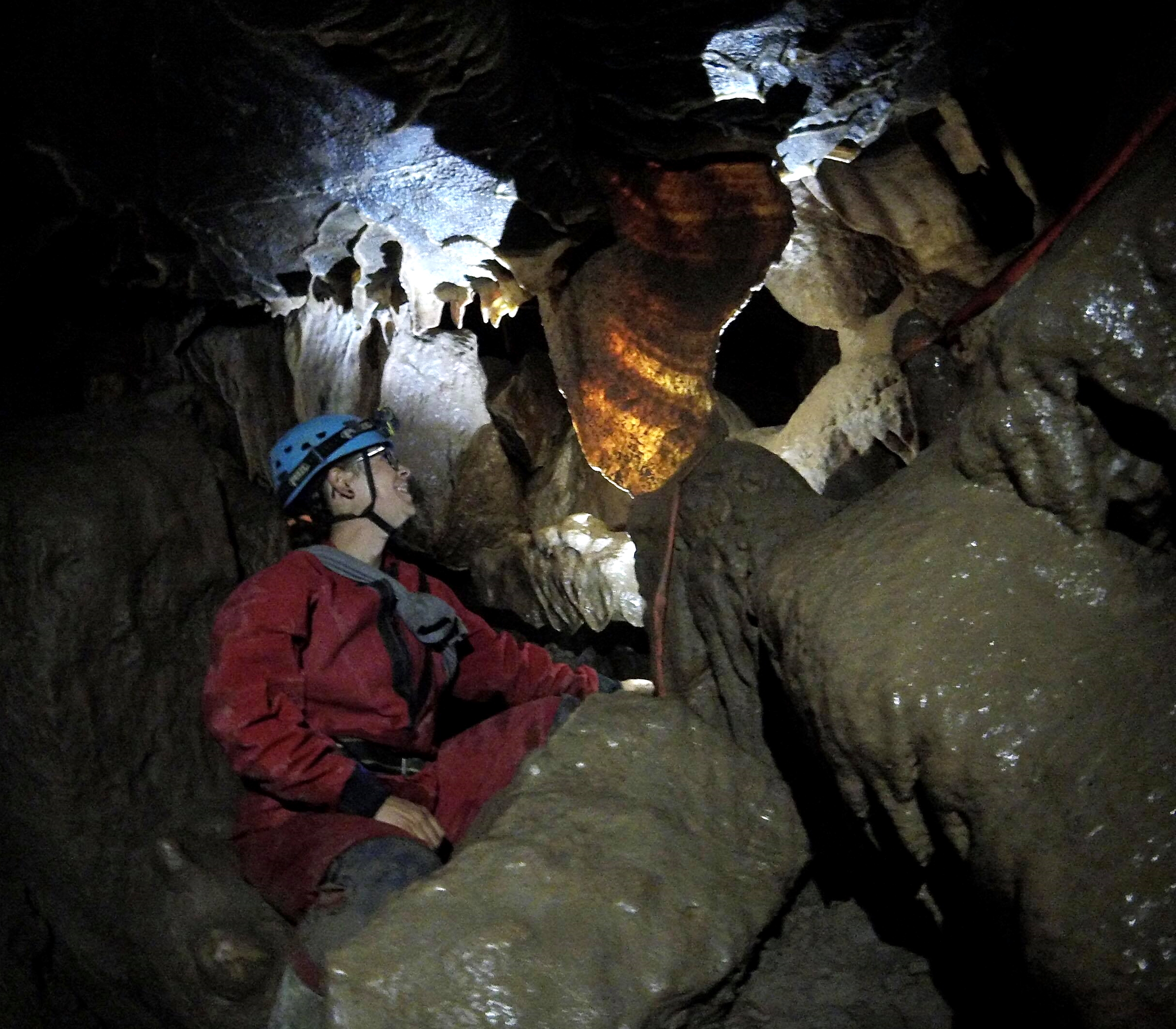
Kat in Fairy Cave.
And all different caves this time!
Many thanks to Jakob Annerdal for this trio of reports covering Porth yr
Ogof in Wales as well as, Thrupe Lane and Fairy Cave on Mendip.
FAIRY CAVE: pretties, crawls and squeezes.
On the 10th June Kat and I went to Fairy Cave with no particular
intention besides having a good trip and looking at some pretties.
Fairy Cave has turned into one of my favorite Mendip trips after my two
recent visits. It offers easy-going walking passage after only a short
crawl and a lot of interesting things to look at along the way including
the aptly named Tar Hall.
At the end (assuming a through trip from Hilliers to Fairy is attempted)
there is a sporting squeeze leading to a duck (which in our dry
conditions was more of a puddle) leading to a crawl! There are lots of
curtains and stal to gaze upon as well.
PORTH YR OGOF: A not-quite-swimming-extravaganza
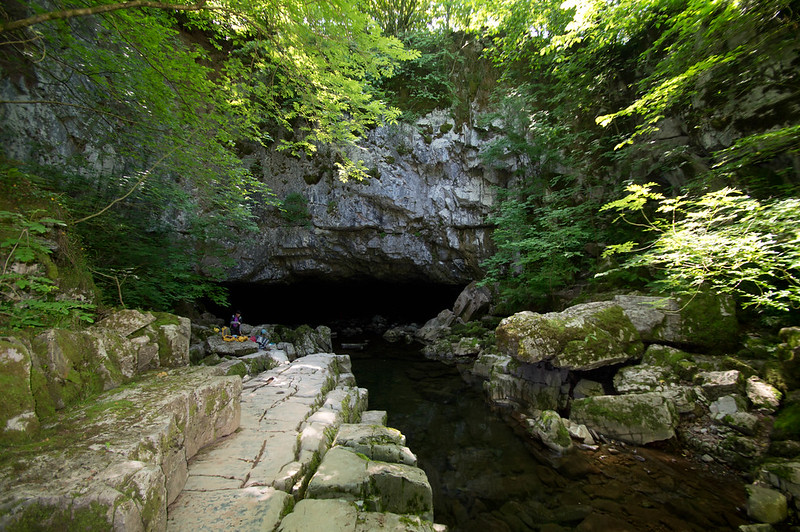
Entrance to Porth yr Ogof, Photo by Mark Burkey and used with his kind permission
On the 22nd June, Haydon invited myself and
Sara Ha on a trip to Cardiff to pick up a fish tank purifier sold by
some bloke on eBay, with caving more of a side-activity. Jokes aside,
after arriving at probably caving’s most convenient carpark and deciding
against wetsuits because of the perfectly dry conditions - we entered
the cave through the main entrance. Despite concluding that the water
was indeed very low, we took the swim-bypass.
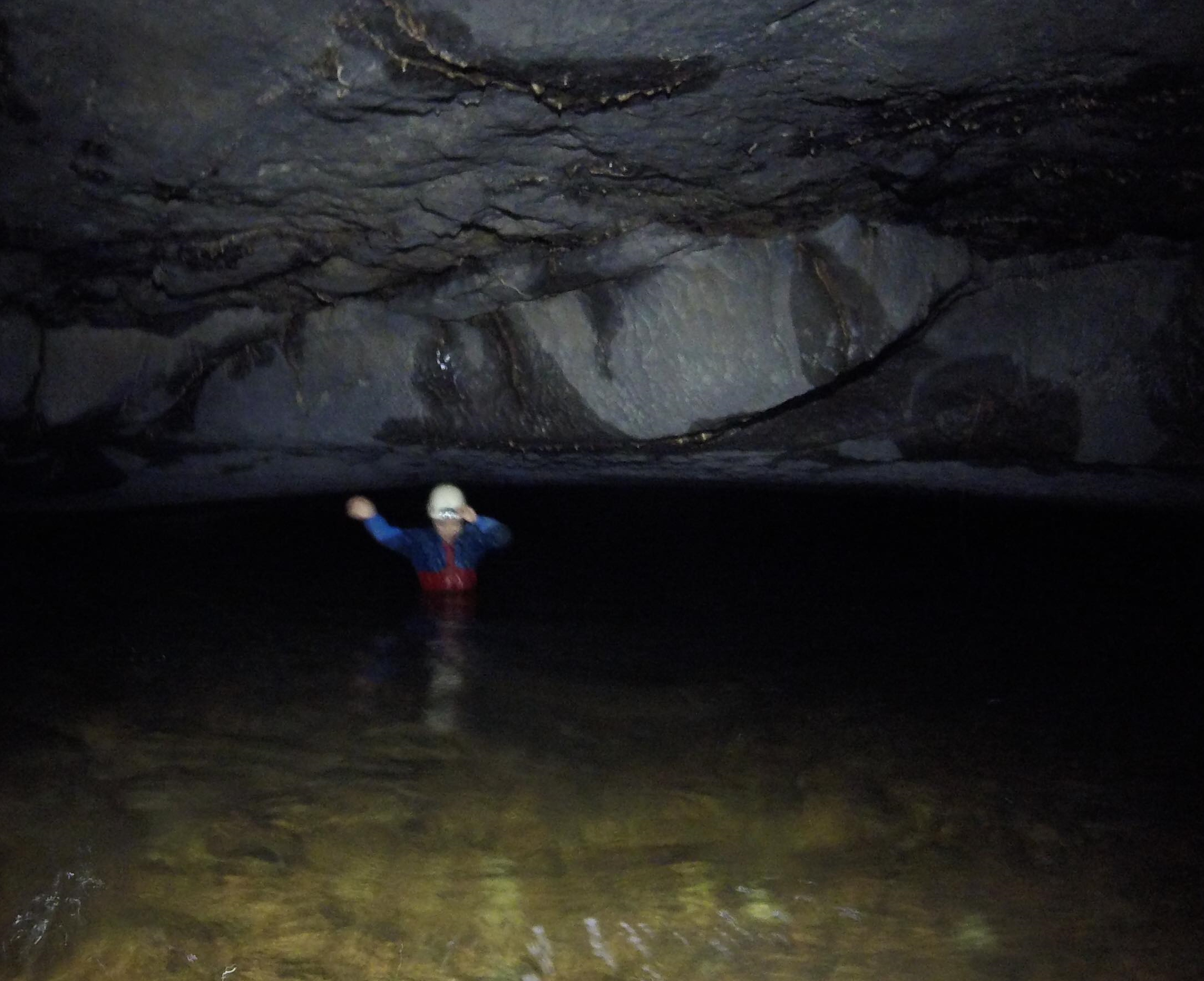
And a good time was had by all! No one was drowned in the taking of this photo.
Porth Yr Ogof, whilst not a big cave,
offered much fun in the classic; water-park-for-adults, sort of way a
bit further in. For me, doing the armpit high wade proved particularly
adventurous - it is easy to see how, in higher waters, people could have
been swept away in the currents - proceed with caution! We exited
through a second entrance (out of 15 possible ones) and walked down a
gully to look at the resurgence, which is famed for its strange
undercurrents and dangerous tree debris - here it is strongly advised
not to swim (seriously, it's basically A Rule).
Afterwards we retraced our steps and did the through trip again to the
main entrance - but not before crawling around ‘the maze’ (which is
surprisingly maze-like for such a small cave!). Porth Yr Ogof, we
thought, was a lot of fun and well worth the trip!
THRUPE LANE SWALLET: SRT on nice fluffily-named pitches.
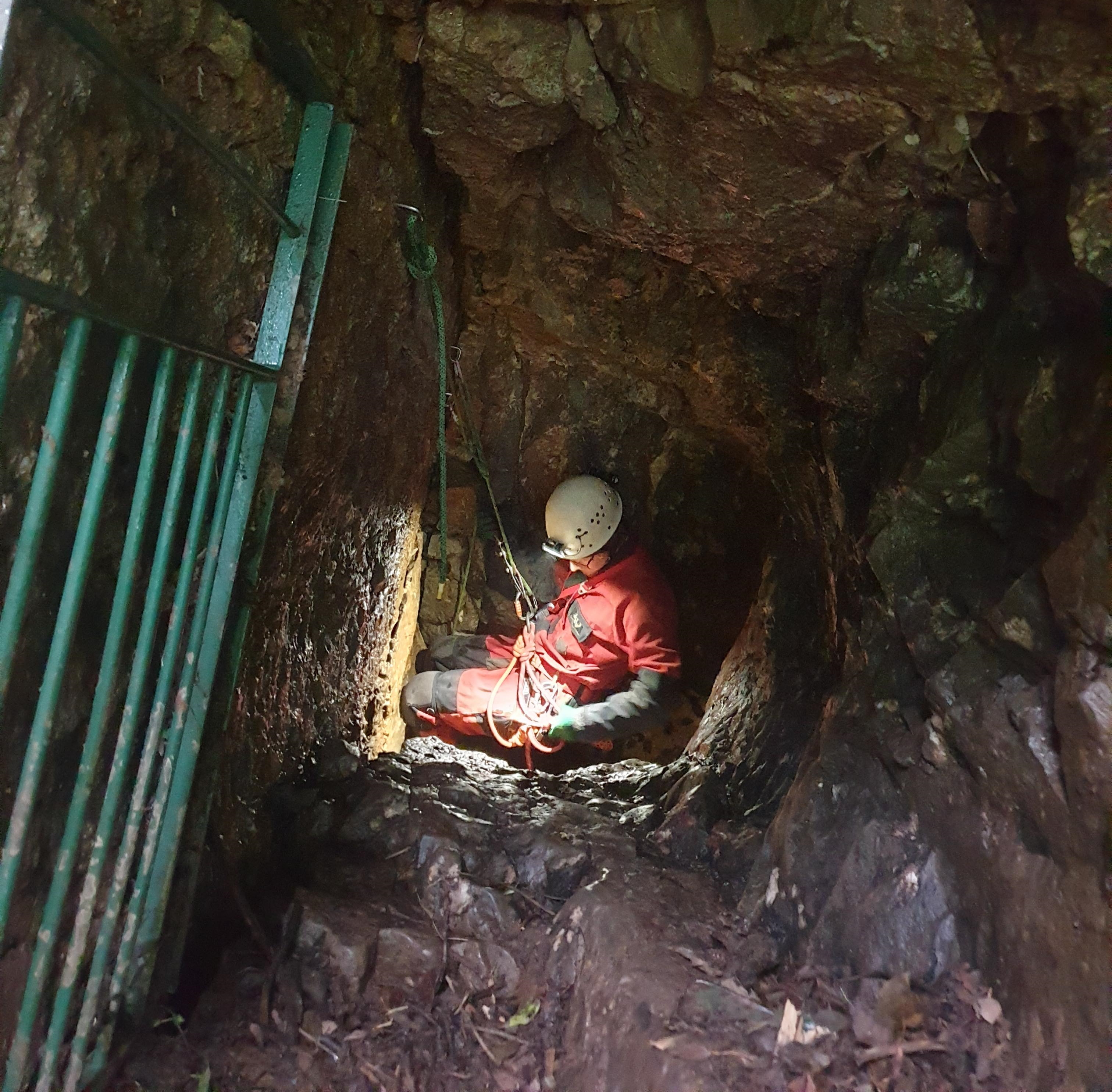 Thrupe Lane entrance pitch. Thrupe Lane entrance pitch.
In preparation for the Berger, Haydon and
Merryn and I left for arguably the Mendips' best SRT trip on the evening
of the 2nd June!
After exactly zero faff getting ready, our car left the SU at a very
reasonable 5:30pm - totally. We arrived, established that one of our
members had sadly forgotten all the caving gear required - and callout
was sorted, with Merryn doing the honours!
An efficient party of two entered the cave after packing some tackle
sacks and off we went. Thrupe Lane Swallet (despite the survey being an
utter chaos) is relatively straightforward. There's a short entrance
pitch to get you started, then some sideways shuffling through some
fossil-covered, sharp passage. Eventually you reach Perseverance Pitch,
so-named for its easy-going, flowery and fluffy characteristics. Moving
on, I got somewhat confused direction-wise, but eventually we found the
phreatic tube that leads to Marble Streamway. We rigged the traverse
post-streamway and bottomed out the cave on the Lateral Pitch.
Jakob Annerdal
|
|
AN INAPPROPRIATE WEEKEND IN SOUTH WALES, APPARENTLY
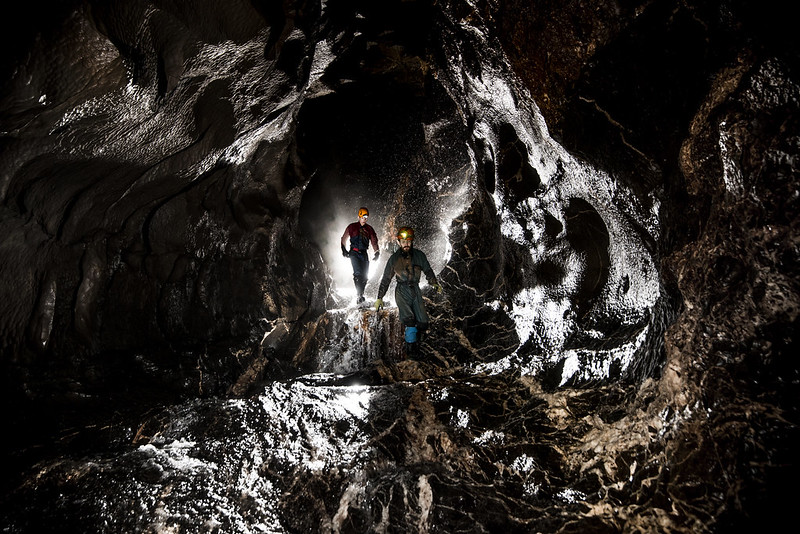
OFD Main Streamway. Photo copyright Mark Burkey and used with his kind permission.
Sioned Haughton has provided a poetic round up of a recent weekend in South Wales, with footnotes. How academic is that!
Eight of us went off to cave in OFD (1)
Two through trips were planned plus a jaunt to Three (2)
We all went in top
Since covid has put a stop
To the traditional method of getting a key (3)
I took Kat and Si down the streamway
Kat had never been and thought it was dreamy
So she came up trumps
With my extended tour of the sumps
Which included both those real and imaginary (4)
We eventually reached the Confluence
And made a few tentative forays whence
But my route finding lacked clout
And time was definitely running out
So retracing our steps made the most sense
At this point my mood was a little sour
But fortunately Si had ample reserves of power
So with a smile and a wave
He fairly ran out the cave
And made it out in well under an hour (5)
Kat and I met the others at Maypole Inlet
Turns out their call out had also been unrealistically set
So we went out as we came in
A big long snaking thing
But this time all a good deal more wet
The next day we were keen to get back underground
I certainly wanted to make sure the way could be found
But we had to alter our original objectives
Due to SWCC's new covid directives (6)
Which deemed our request for an additional key to be unsound
But despite being branded 'inappropriately late' (7)
Sunday's caving trips were actually great
We took our *one key*
And caved right through OFD (8)
And would you believe we were all home by eight?
(1) Ash, Elaine, Haydon, Jakob, Kat, Merryn, Si and myself.
(2) Top - Three - One and Top - One, with a detour to the start of Three.
(3) More on this later.
(4) No. Any further explanation will only make me look foolish.
(5) 49 minutes, I believe.
(6) The interim access guidelines and procedures (all six pages of them) can be found on SWCC's website.
(7) I object to this. Nowhere in the above guidelines does it specify a minimum notice period.
(8) Technically only two out of three were through trips. Cwm
Dwr-Top (Ash and Merryn) and One - Top (Haydon and Elaine). Me, Kat and
Si went back to the Confluence, going in and out of One this time.
Sioned Haughton
|
|
ST VINCENT'S WELL: No torch left behind (well, not for long)
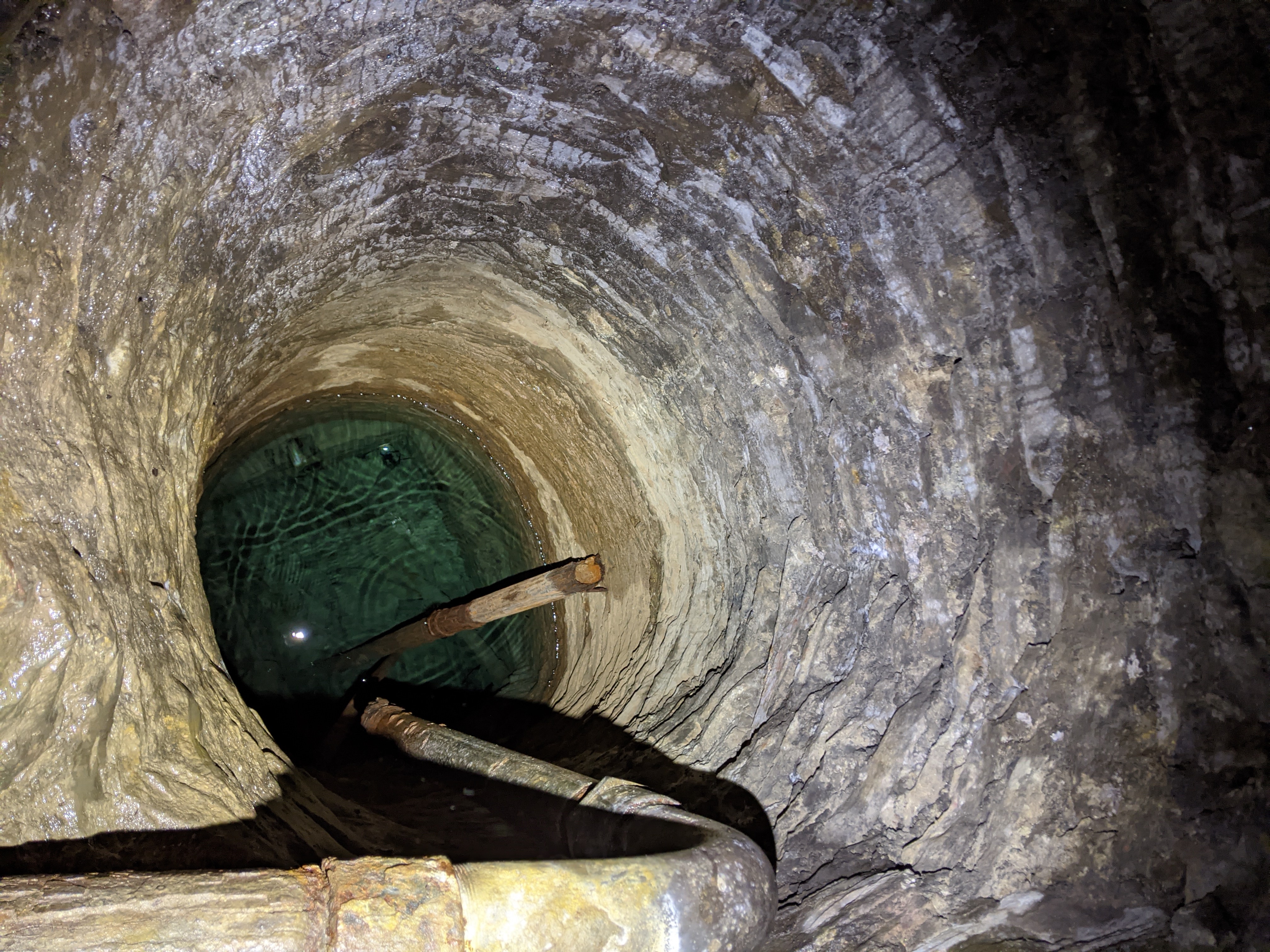
The well in St Vincent's Spring. Th pinprick of light bottom left is David's torch.
Work in this fascinating site
continues, with reports here from Merryn Matthews and David Richards.
Merryn tells her side of the story first...
On Sunday 6th June, I visited St Vincent Wells spring with Professor
David Richards to continue his monitoring project of the hydrothermal
well (~21C). Despite having walked past the ornate pump station many
times, I hadn't realized that just behind you can descend to visit the
well and see the archaeology of its previous usage, such as an electric
pumping system. The actual source of the spring is hidden in a sump, and
it is unknown what path the water takes to get there. David explained
that it is likely from mixing of groundwater, rainfall, tidal water, and
a hydrothermal component (probably the same origin as the hydrothermal
waters in Bath).
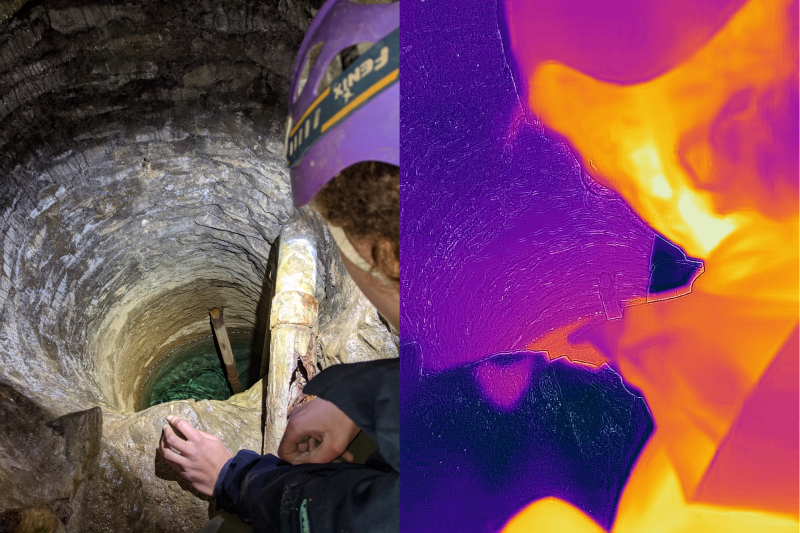 Head of the well and head of the Merryn. Photo on the right by infra-red. Head of the well and head of the Merryn. Photo on the right by infra-red.
We replaced the temperature and pressure
monitors, thankfully still in place due to Zac's hiding skills on the
previous trip. Quickly reviewing the data, which has been logging over
the last few months, showing temperature changes nicely correlating to
the tides. The trip also included some hilarity with David losing his
headtorch to the well, and a valiant (but unsuccessful) attempt to fish
it out with a makeshift metal hook and zip ties.
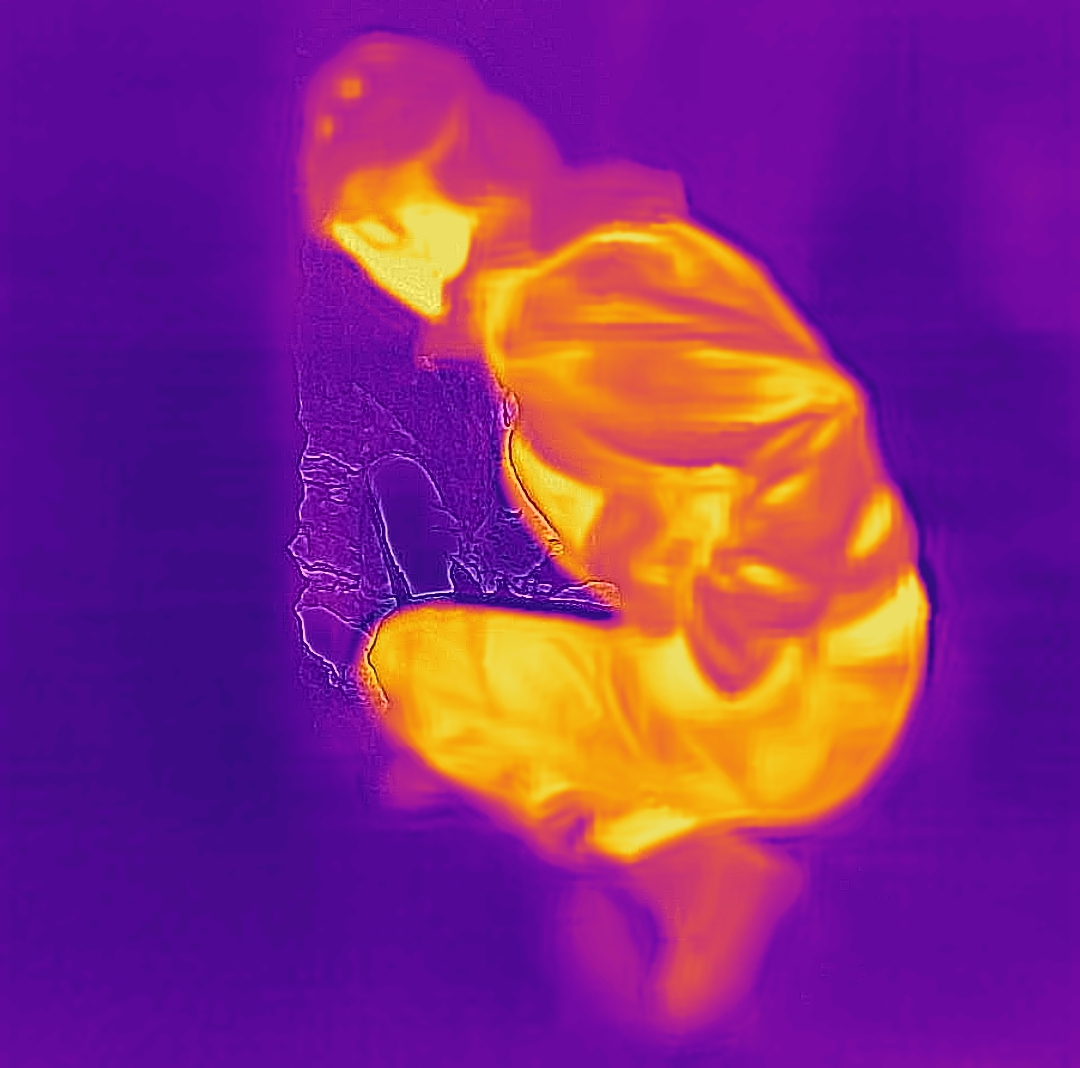
Merry looking hot. Photo by David Richards. Very arty!
Pictures were taken using an infra-red phone attachment, which instantly makes looking down a well cool (or hot?).
Merryn Matthews
David Richards now takes up the tale...
After our successful mission to download water levels and temperature
data (10 minute intervals from February to June), a couple of weeks
later I was assisted by David Hardwick (UBSS/Hades) and Andy
Brander (Hades CC), who were keen to revisit St Vincent's ring and
consider strategies for survey and linking data with Ordnance Survey and
Avon river/tidal data. Andy 'volunteered' to descend the well shaft to
check some survey values and retrieve a caving light from the floor of
the shaft, after loss earlier in the month - not for financial reasons,
rather mitigation against potential contamination* of this unique site.
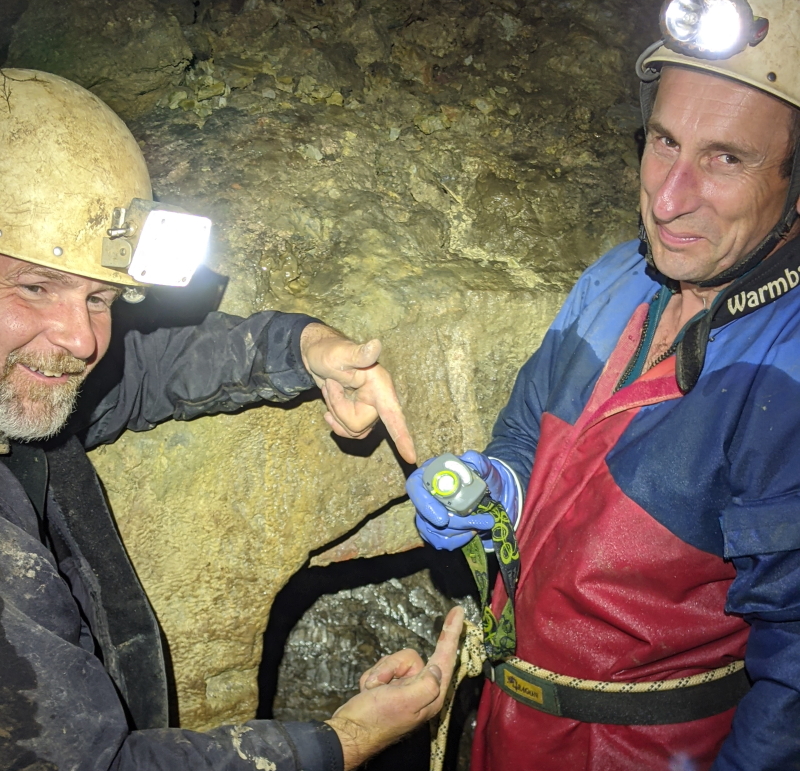 No light left behind! David Hardwick (left) and Andy Brander (right).
In time, we might be able to calculate the
flow, mixing and stratification at this site, where temperatures have
been between 20-22 degrees Celsius, but responding quickly to input of
cooler meteoric water after rainfall events and input of tidal waters.
No light left behind! David Hardwick (left) and Andy Brander (right).
In time, we might be able to calculate the
flow, mixing and stratification at this site, where temperatures have
been between 20-22 degrees Celsius, but responding quickly to input of
cooler meteoric water after rainfall events and input of tidal waters.
A successful mission was accomplished in the presence of a dead rat
floating at the surface, which begged the question "How many rats would
have seen a similar fate in the last two centuries.. and what
would be the geochemical impact?". On exit from the site,
curiosity about hydrological links with the Avon prompted a search along
the muddy banks for potential candidate springs and pipes.
David Richards
|
|
COMMUNITY CAVING IN PEN PARK HOLE
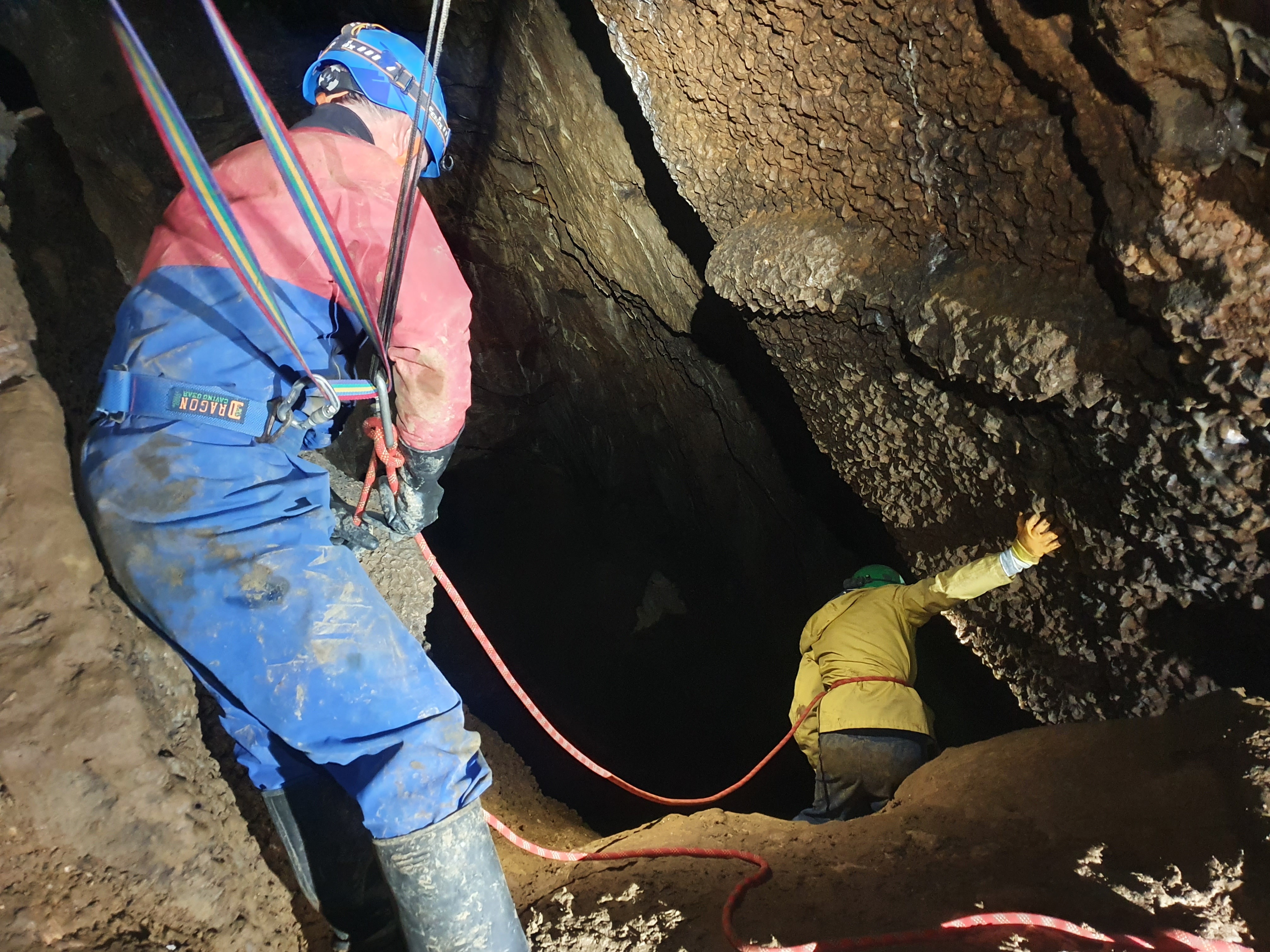
Clive life-lining at the head of the pitch.
A conversation in Henleaze Lake led
to Linda Wilson and Clive Owen taking three members of a local GP
practice for an evening trip down Pen Park House.
One thing I always enjoy is taking non-cavers down Pen Park Hole and
watching the absolute amazement on their faces when they realise that
they are actually inside a giant hole in the ground .surrounded by
crystals.
On this occasion, our companions were three of the staff of a local
doctor's practice, there as a result of a chance conversation whilst
swimming. None of the three had ever been underground apart from in a
show cave and although they'd looked at the website, it was clear that
even watching the films on there hadn't really prepared them for the
reality of being underground.
While we were sorting out helmets on the surface, with Clive and I in
full kit, a passer-by stopped to ask if we were going underground and
chatted for a few minutes about his memories of the old concrete slab
that covered the entrance, then a younger guy in his 30s dashed up and
asked the same question, and was really keen to visit the cave as his
house practically overlooks it. He was delighted when we said we'd
happily take him and we directed him to the email contact on the
website. Then as we were walking to the entrance, we gained another
person, who was equally interested and keen to see down the entrance
pipe.
The local people who stop to talk all seem to know about the cave and
are absolutely fascinated by it, and when there was a threat from an
ill-advised development on the site of the old Wayfarer pub, the locals
all rallied around a campaign they set up themselves, with Save Our Cave
badges and teeshirts and even organised a party in the open space to
mark the granting of its status as the latest Site of Special Scientific
interest. It's one of the few places where putting on a muddy oversuit
by the side of the road can be pretty much guaranteed not to piss anyone
off.
So if you're ever going down the cave, do take the time to chat to
anyone who is interested, and if they'd like a visit, get them to use
the contact email on the website so Graham can find a leader for them.
It's very much 'their' cave and it's great for people to be able to
visit and see it for themselves. Don't feel you need to hurry away from
people without talking in case they disapprove. You're very unlikely to
encounter that sort of reaction.
Our three companions all threw themselves into the experience with
evident enthusiasm and enjoyment and had no problem with any of the
squeezes, and they were all happy to approach the ledge, life-lined by
Clive, and lean over so they could see the water, which was pretty low.
They all came out muddy and positively buzzing from the experience.
C02 levels were very low, with my breathing only slightly elevated in
the third of the squeezes on the way in and out. We all had a really
nice early evening trip.
Linda Wilson
|
|
BUCKETS, BONES AND EVEN SOME POT!
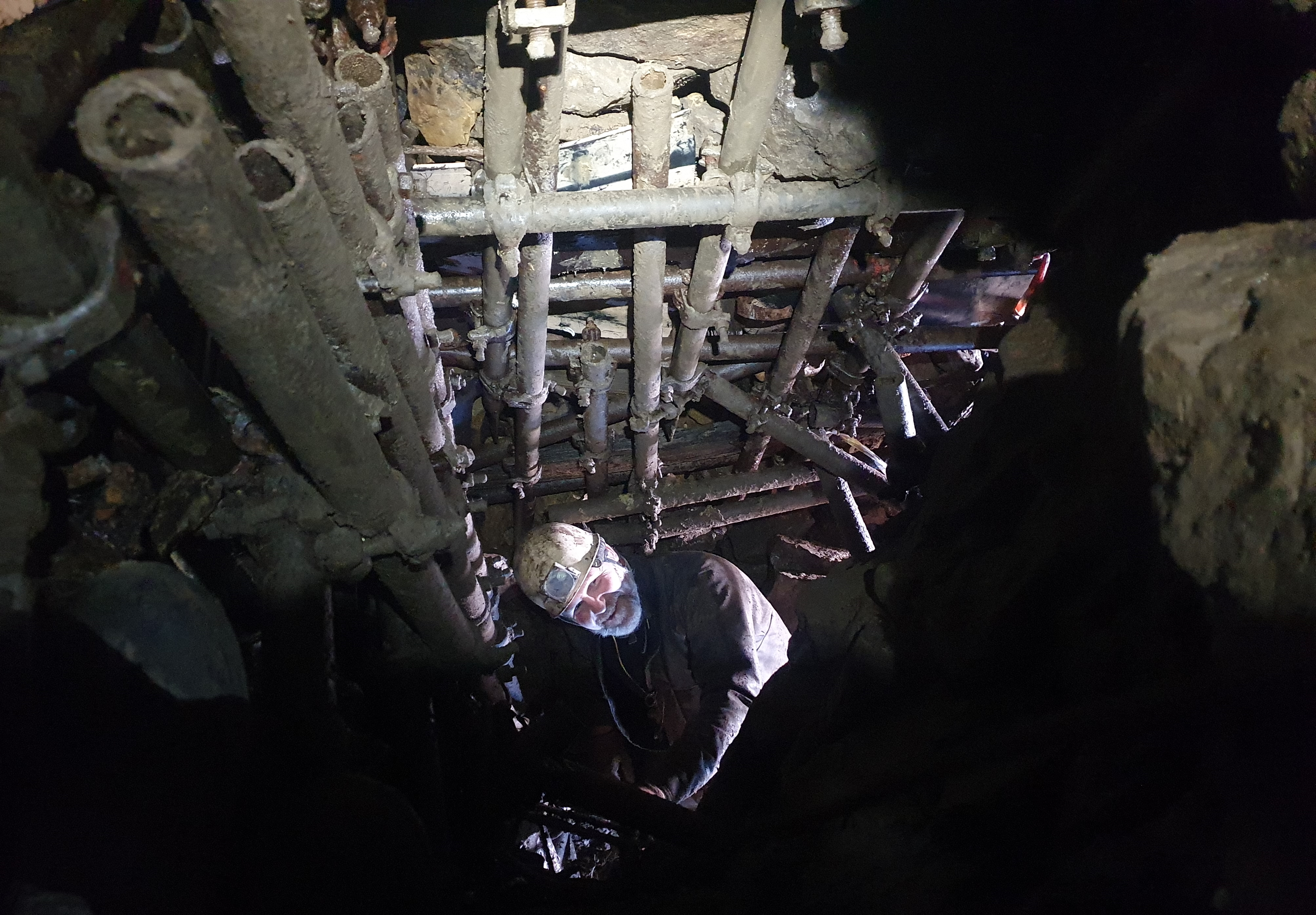
David Hardwick at the bottom of the Fishmonger's entrance shaft.
For the first time in many years, UBSS members are involved in
an archaeological dig again, this time at Fishmonger's Swallet in South
Gloucestershire. Museum Curator Linda Wilson gives an update of work at
the site.
As newsletter readers will remember, Fishmonger's Swallet is a
fascinating site dug into nearly 25 years ago by members of the Hades
Caving Club. The discovery of a large quantity of bone, both human and
animal, led to a lot of interest and a dig by Time Team (the episode is
still available on YouTube). Three years ago, the material from the site
was donated to the UBSS museum by the owner, Mrs Joan Hawkins.
An analysis of the bones is now under way at Cardiff University as
Adelle Bricking, who I've worked with on various UBSS collections, is
looking at the human remains as part of her PhD on Iron Age mortuary
practices (which can probably be summed up as 'yeah, they did some weird
shit') and Jess Peto from Cardiff has kindly volunteered to produce an
updated faunal report on the animal bones and is now looking at the dog
bones in particular as part of her Masters.
A selection of human and dog material from the earlier digs is now with
Tim Knowles in the University of Bristol's radiocarbon dating facility.
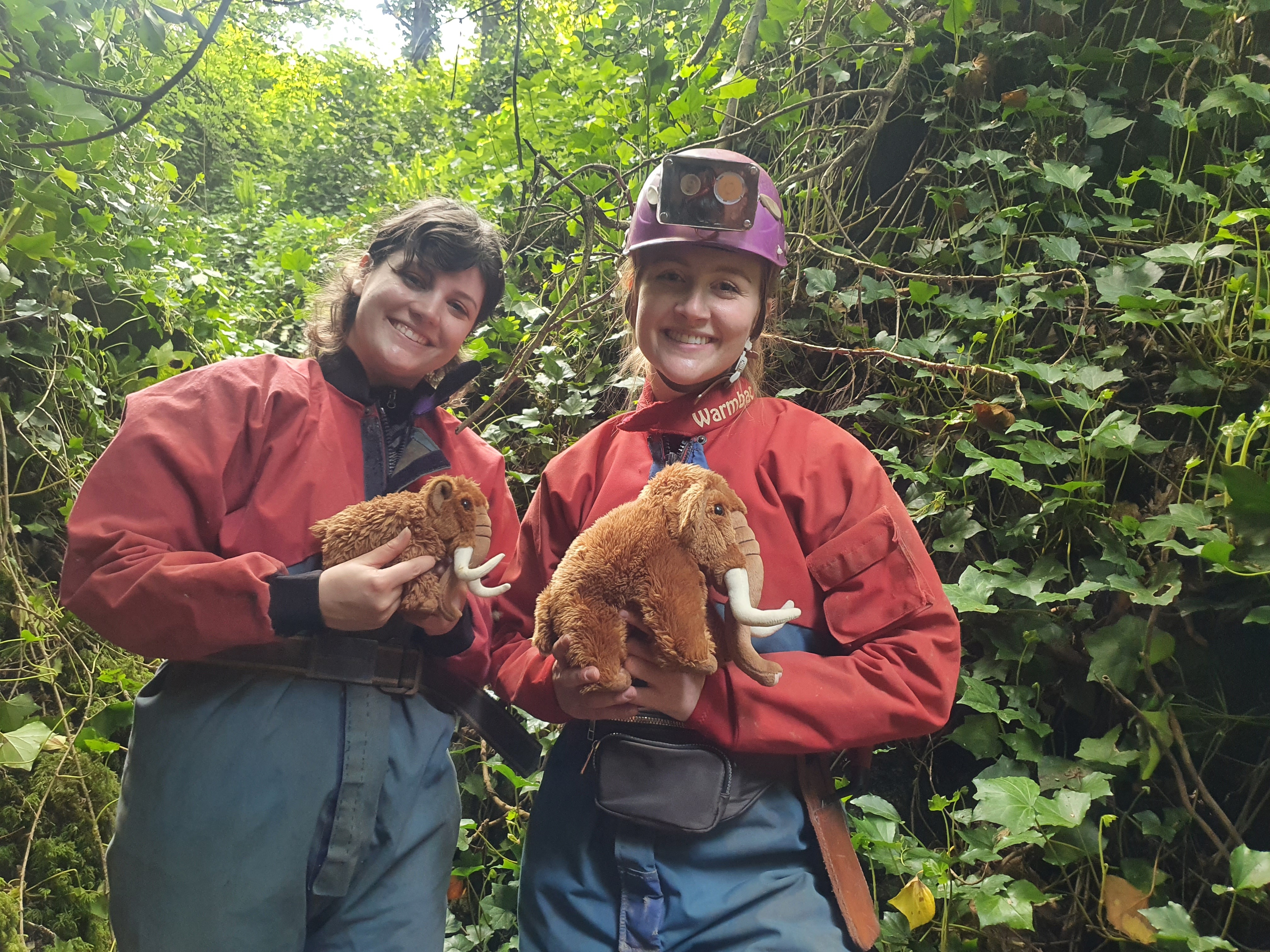
Left to right: Jess Peto with St. Front and Adelle Bricking with Whatley Mammoth.
In addition, UBSS/Hades member David
Hardwick, one of the original discoverers of the cave, has long
harboured an ambition to make a film of the cave and the approach of
25th anniversary next year has been a good way of kick-starting this
project, fuelled by the success of film maker Nathan Cubitt's short film
'Death and the Maiden' made for the Bristol Alumni Spring Showcase in
March this year. Nathan and Hades member Paul Taylor, an experienced
underground film maker, are now collaborating on the project and work is
well underway.
As part of this, it seemed like a good idea to introduce Adelle and her
colleagues to the site itself, and they were game for an adventure, so
on 2nd June a party consisting of myself and UBSS members David
Hardwick, Nathan Cubitt, Tony Boycott, Jan Walker, accompanied by Jack
Rendell (Hades) and Cardiff Uni archaeologists Adelle Bricking, Jess
Peto and Richard Madgwick set off down the cave.
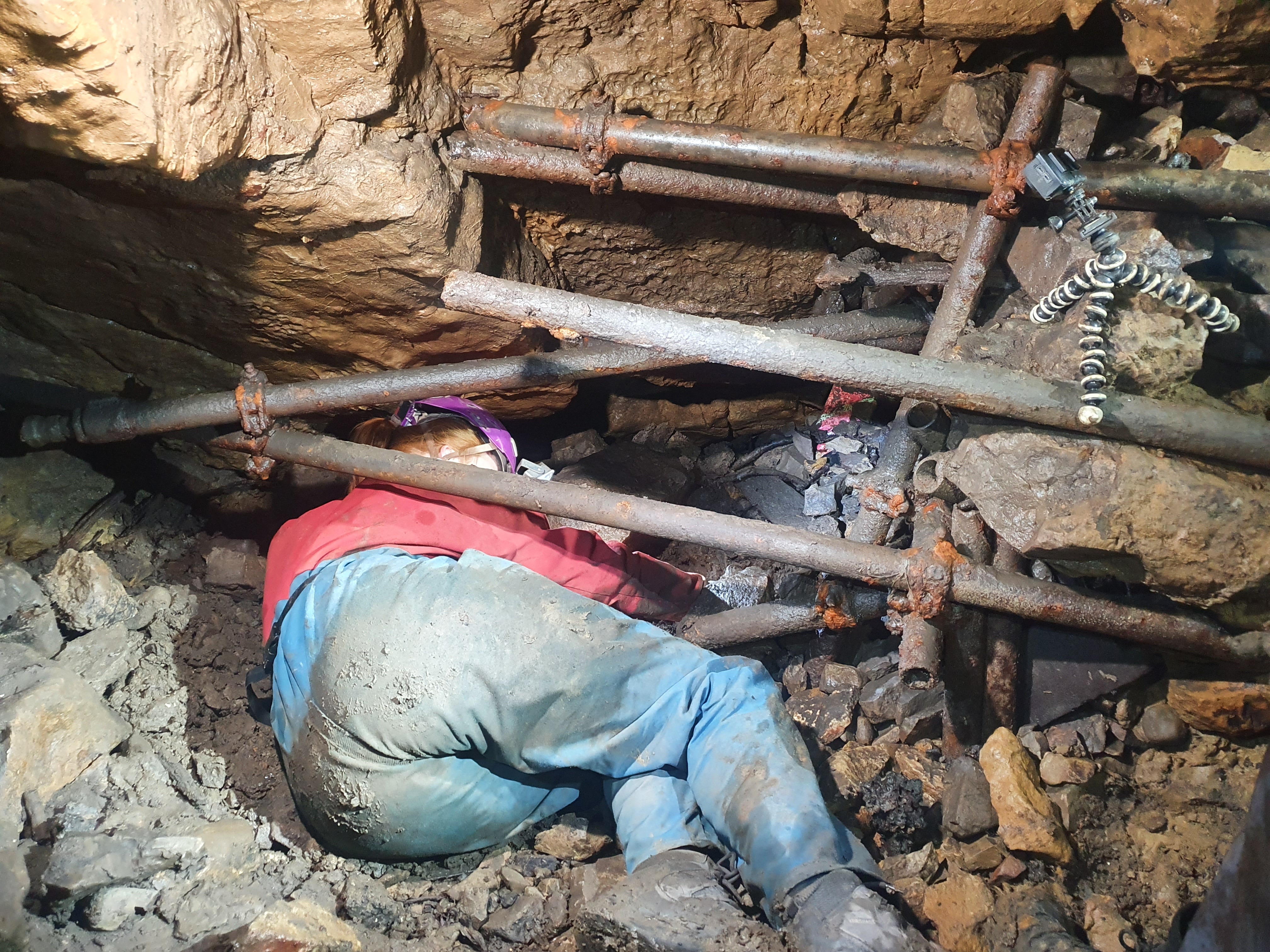
Working conditions in Bone Idle Chamber. Adelle digging.
While the archaeologists were being filmed
working in Bone Idle Chamber (the first chamber at the base of the
entrance shaft where the bones were found), the rest of us started
hauling buckets of mud and rock to the surface. Even with a pulley to
help hauling at the top of the shaft, it's still an awkward business,
needing at least three people positioned in the shaft, with someone on
the surface and (to put it mildly) it's bloody hard work, but is often
accompanied by a commentary from below including phrases like 'human
tooth!', 'dog bone', 'songbird's leg bone, not sure which species' (yes,
Rich Madgwick is very, very good at identifying faunal remains), 'rib,
might be human' and 'MORE POT!', the latter causing great excitement on
our second trip as one piece of pot had come out of the mud on this
first trip but had gone unnoticed until cleaning in the lab as it had
originally been thought to be a chunk of a cranium.
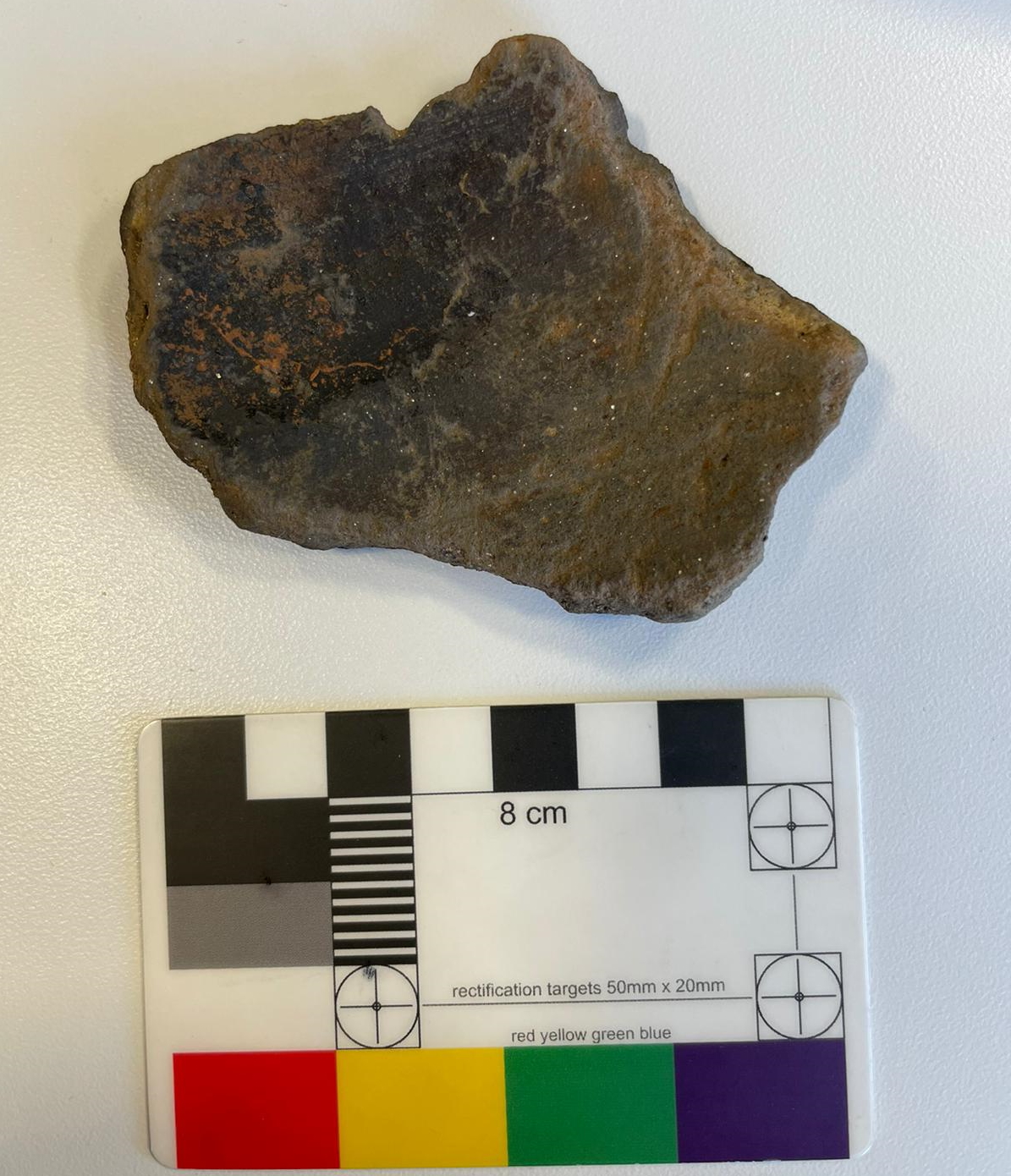
Pot fragment, burnished ware of some kind,
either late Iron Age or early Roman, which fits nicely with the existing
radio carbon dates. Photo by Adelle Bricking.
Nathan and David made another trip to do
some more filming and David did more work underground on other trips as
the addition of more scaffolding at the base of the shaft was a priority
as naturally the archaeologists wanted to dig right underneath it, so
safety dictated more shoring was needed.
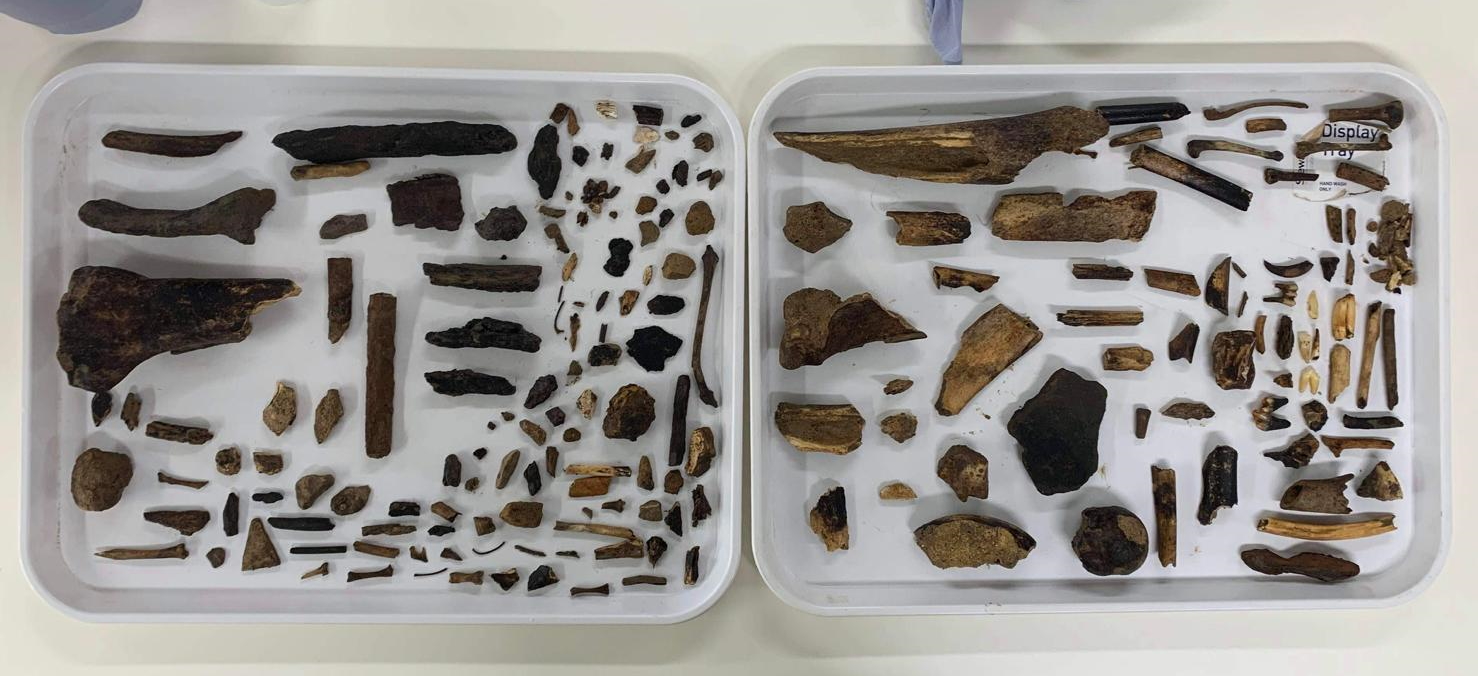
Finds from trip on 2nd June after cleaning.
Included human tooth and fragments of both human and animal bone and
one piece of pot, shown above.
By the time we returned en masse on 27th
June, the numerous trips over the past few weeks had make the entrance
shaft more greasy than an oiled pig, so progress up and down was a tad
more challenging. Jan Walker and I ferried a vast amount of filming gear
down the shaft and with each bag's contents worth about £1,000 there
was absolutely no pressure not to drop anything! We then returned to the
surface for numerous shots of us all walking down the stream bed to the
entrance, with Paul tracking our progress on an overhead camera mounted
on a wire strung between the trees, and Nathan taking shots from near
the entrance.
Our archaeological team this time consisted of Adelle and her husband
Chris (who did a massive amount of hauling from the head of the shaft),
Sarah Tucker and Anna-Elyse Young (who took turns digging and then
helping on bucket hauling duty with Jan and myself in the lower part of
the shaft. Tony Boycott (hampered by an arm injury) dealt with buckets
on the surface, doing his best to check that nothing interesting was
hiding in the mud, not so much sieving as squidging).
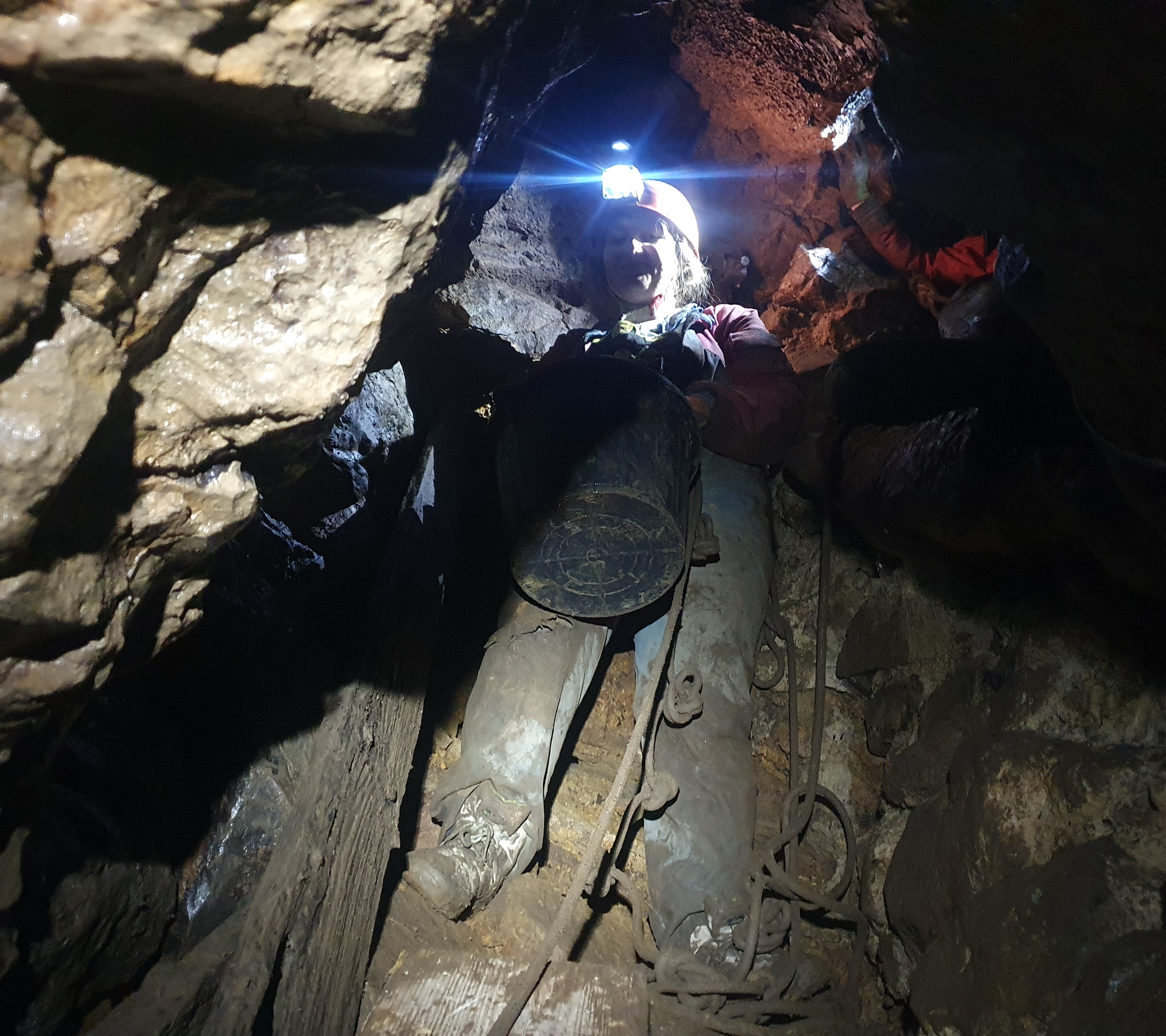
Anna about to heave a bucket up to Jan on the next leg of its journey to the surface.
Four hours of digging and hauling resulted
in more interesting finds with highlights including another couple of
pieces of pottery, a (probable human) rib bone and a section of dog
mandible with a tooth still in situ, which will be incredibly valuable
for the current research.
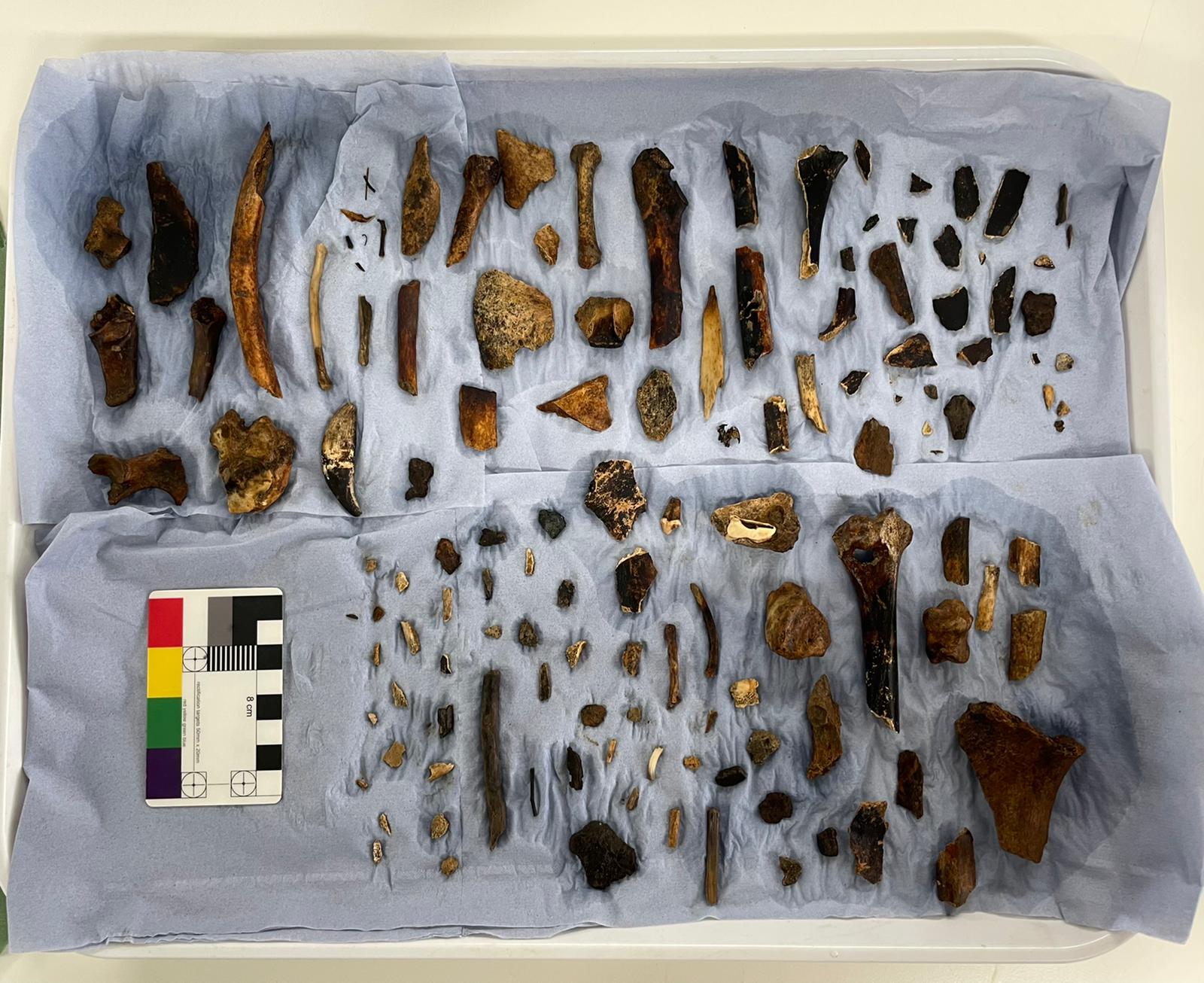
Finds from 27th June.
Notable quotes from the day included the
comment that Linda was busily hauling David's groin up the shaft in a
bucket. He was clearly caught up in the excitement of the moment,
thereby impeding the bucket's progress out of Bone Idle Chamber.
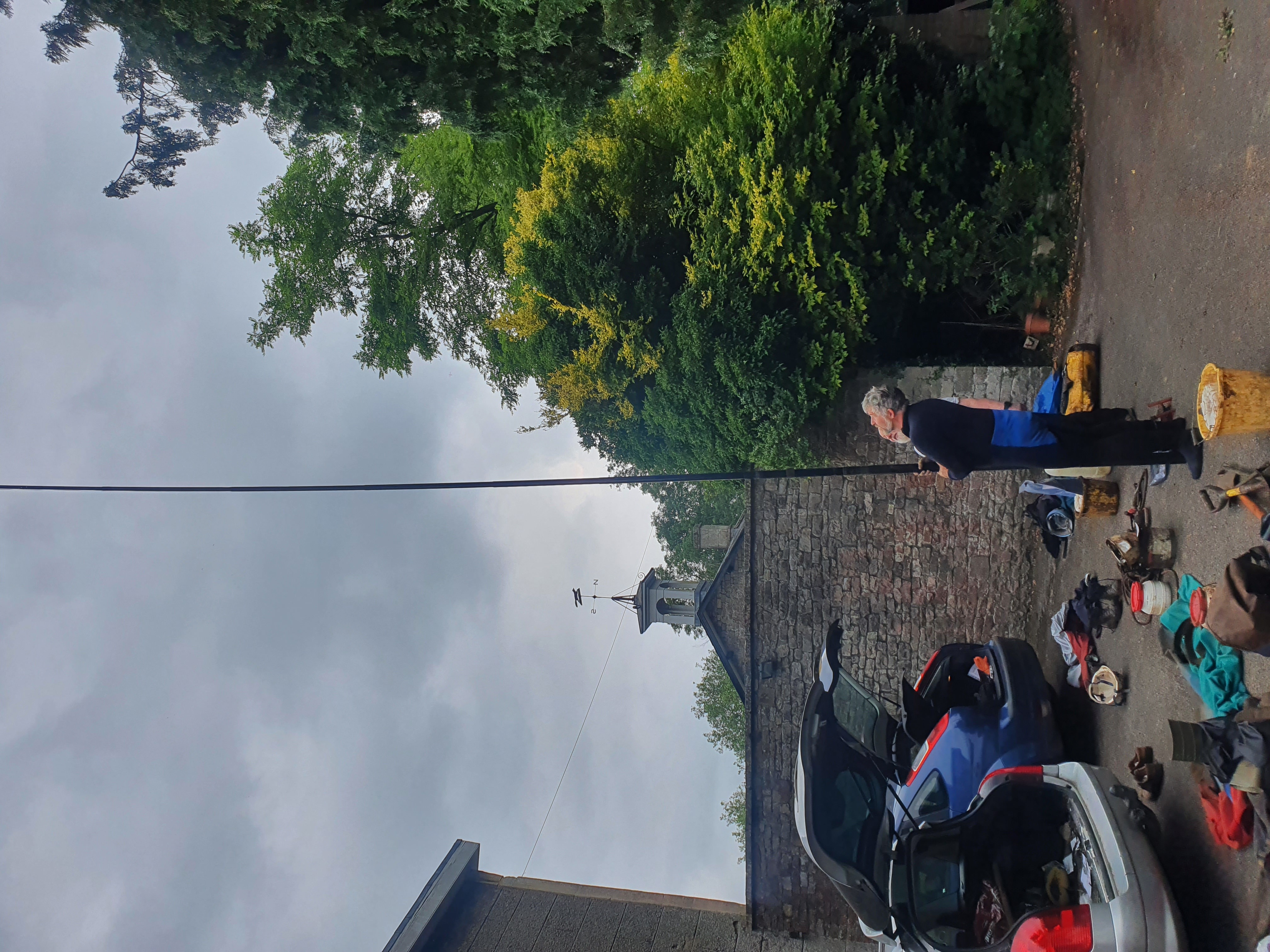
David Hardwick, a clear winner in the day's
'mine is bigger than yours' contest, his groin undiminished by its
close association with a bucket.
More work is planned over the summer, both digging and filming.
Linda Wilson
|
|
BABYFACE CAVE, CLEVEDON
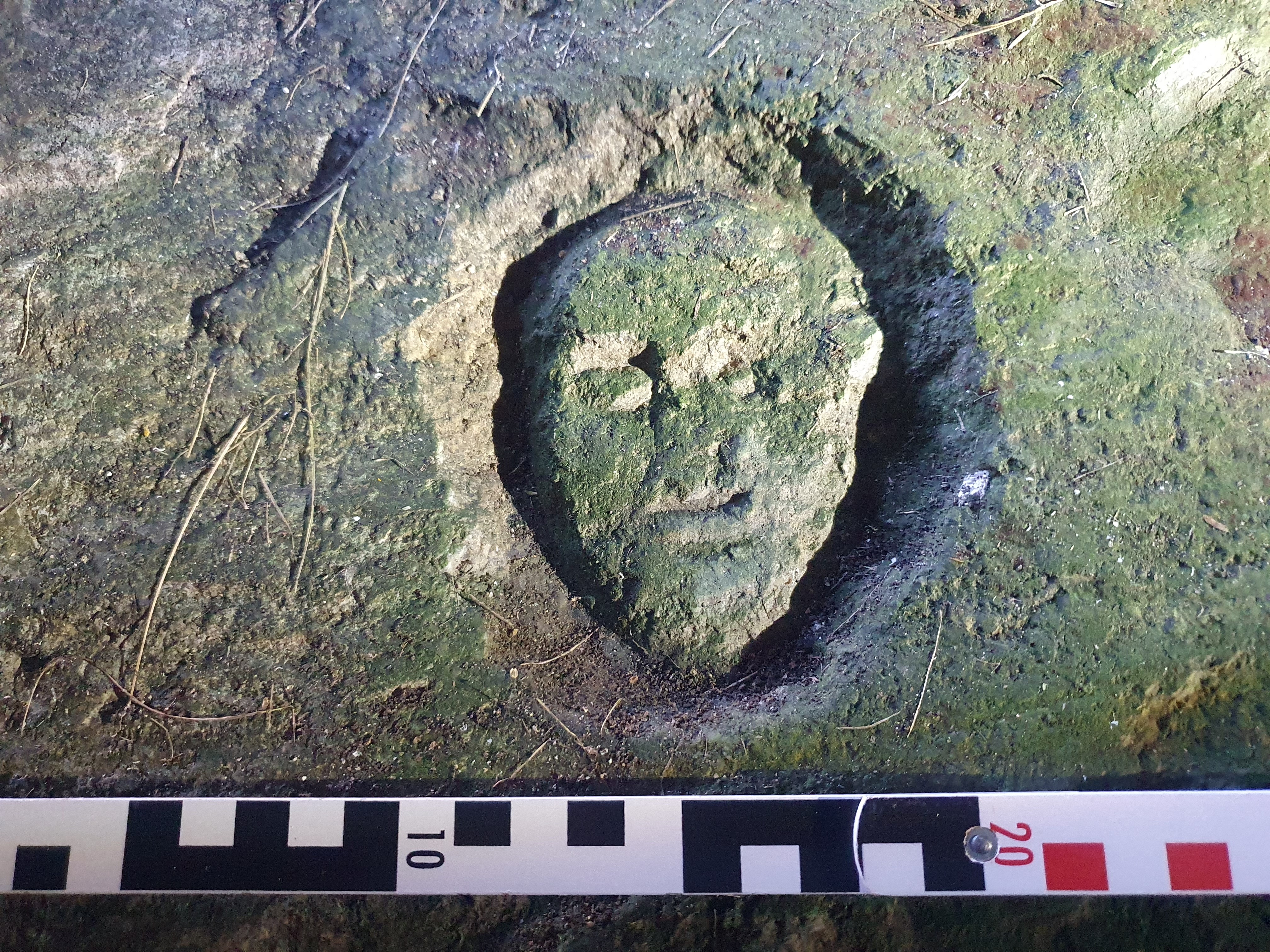
Main carving in the 'cave.'
One of the region's lesser known
oddities is Baby Face Cave, on the coast near Clevedon. Linda and Graham
were shown this many years ago and recently, Linda set out with Tony
Boycott and Jan Walker to see if they could locate the cave, as she
describes here.
I haven't combed through my logbooks to find the entry for my previous
visit to the cave, but memory insists this was at least 15 years ago,
maybe more, so when I set out on 22 June with Tony Boycott and Jan
Walker for a walk along the coast, we were relying almost
completely on the GPS coordinates in Somerset Underground Volume 1.
We parked on Ladye Bay Road and found a path leading down to the top of
the cliff that meets the cliff path itself. We followed this north for a
short way to the north side of Ladye Bay and then picked up a rough
track leading down to the first big shelf above the usual high tide
mark. We then worked our way back south towards the spur at the top end
of Ladye Bay.

Degraded carving open to the air.
The grid ref in Somerset Underground (ST
4093 7308) is pretty spot on. An obviously well-worn little track leads
up beside the jumble of rocks that contains the carving we'd gone to
see. I worked out we were in the right place by looking for - and
finding - the second, more degraded, carving on the exposed rock face at
the bottom of the cliff just to the north of a bolted climbing route,
then if you turn back to the little track you've just scrambled up, the
rock shelter that contains the main carving is on your right.
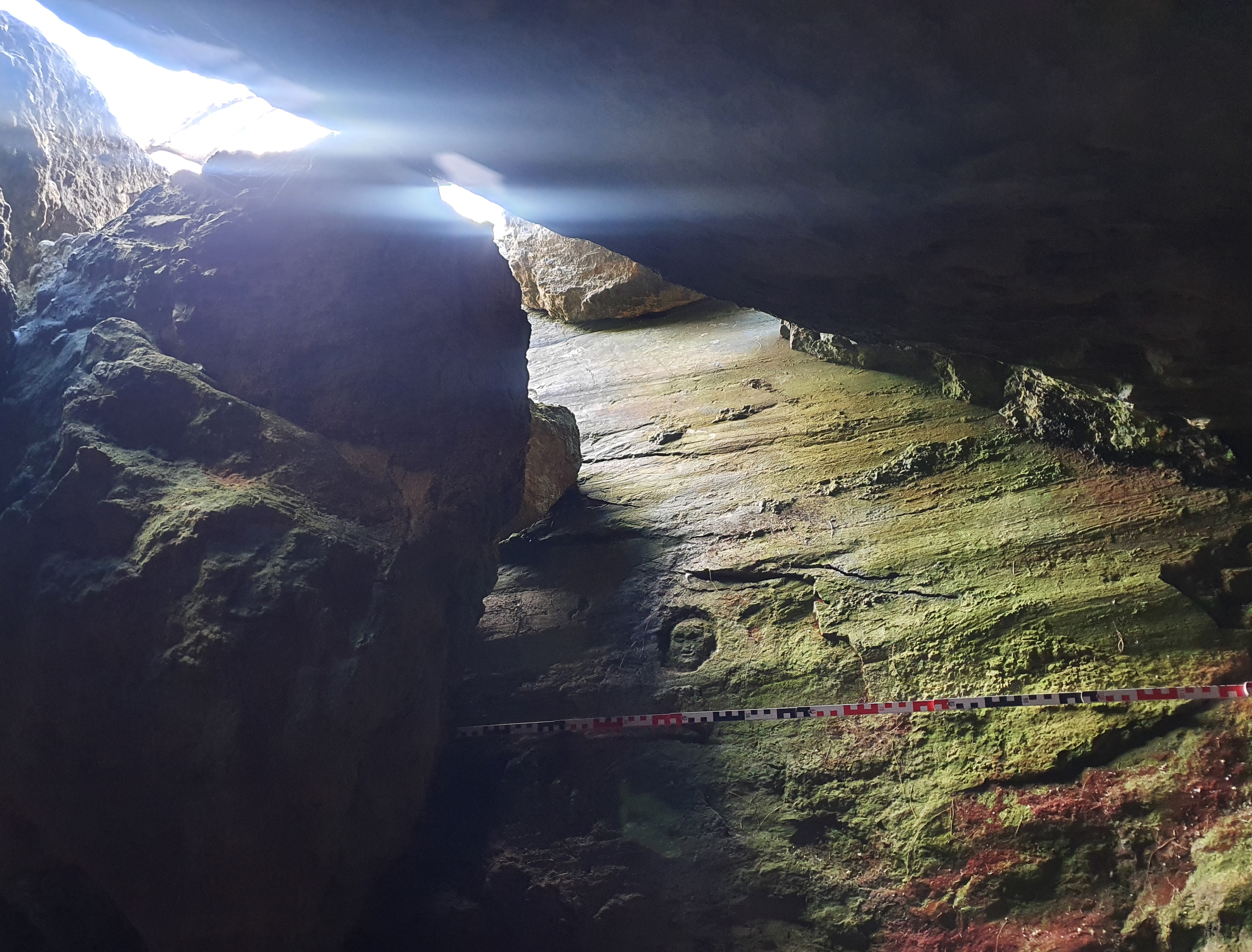
Carving in natural light on sloping slab inside the small cave.
The face is on the rock immediately in
front of you as you scramble down into the rock overhang, turned into a
cave by a jumble of large boulders. Natural light falls on the carving
so whoever did this would have been able to see what they were doing
without artificial light.
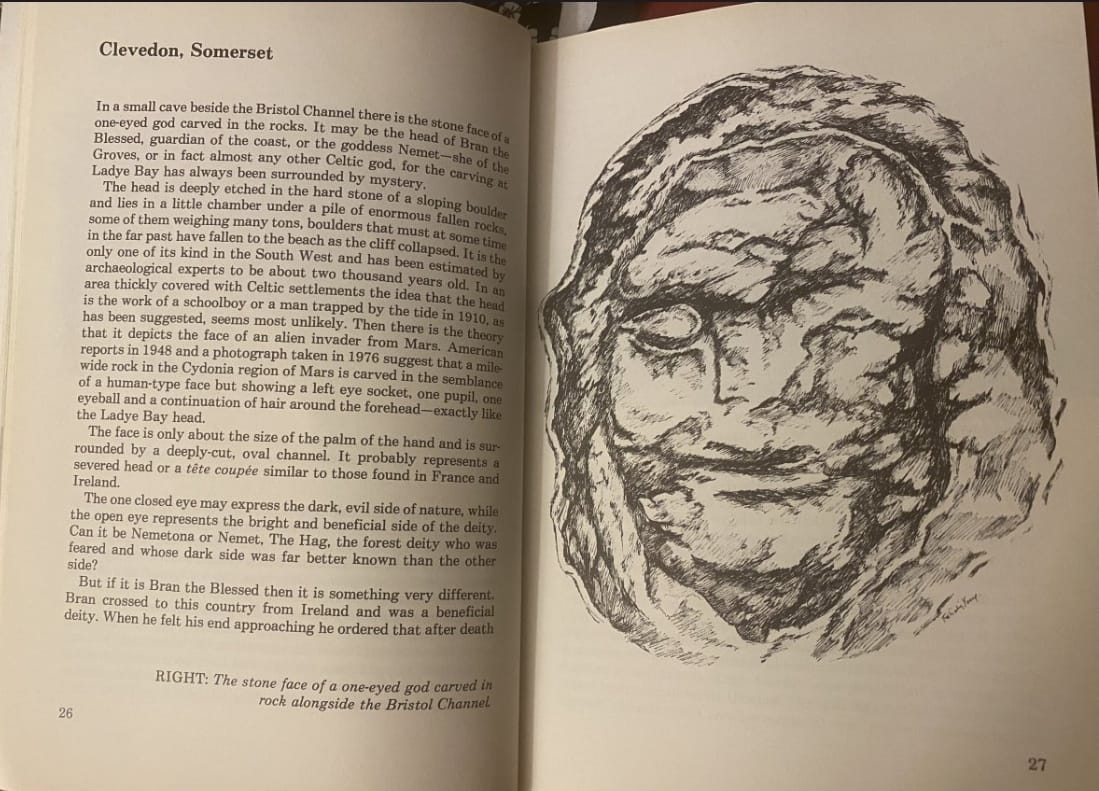
Extract from Mysterious Britain by Peter
Underwood (1988). The carved area around the head appears to have been
misinterpreted here as hair.
Nothing definite is known about the
carvings, although there is a local tale that the carvings were done in
the early 20th century by a stranded fisherman. There has also been
speculation that there are 'celtic' in origin, but this seems fanciful
and dating this sort of rock carving is almost impossible. My own
feeling is that they could date from any time from around 1800 onwards
but it's hard to make any sort of educated guess and we can't even be
sure that the two carvings are contemporaneous with each other.
The entry in Somerset Underground refers to newspaper reports of the
'rediscovery' of the carvings by a local boy in 1967, with claims to
their ancient origins then being swiftly debunked by a 73-year-old man
who countered with the stranded fisherman story. The latter could well
be no more than local 'folklore' although I would like to track down
these reports.
Regardless of their antiquity - or lack of - the carvings are
interesting and this section of coast near Clevedon is lovely and it's
well worth the walk and the scramble to find the enigmatic carvings of
Baby Face Cave.
Linda Wilson
|
|
THIRTEEN LESSONS THAT SAVED THIRTEEN LIVES: THE THAI CAVE RESCUE
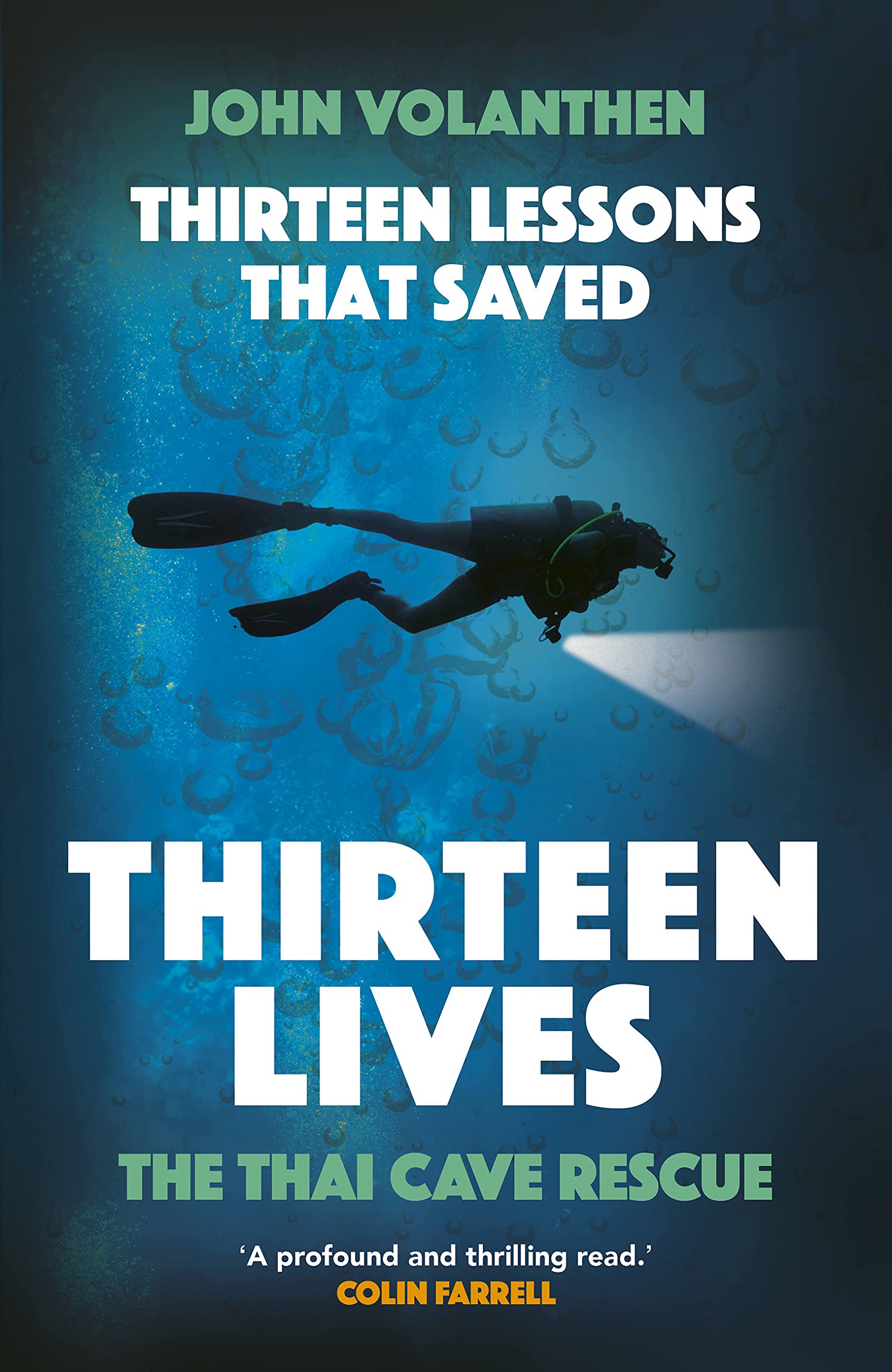
Linda Wilson reviews John Volanten's book on the lessons that helped him save thirteen lives in Tham Luang cave in Thailand.
In the summer of 2018, few people in the world with access to news
reports could fail to have been gripped by the story of the 12 young
boys from the Wild Boars football team and their coach, trapped by a
sudden flood in the Tham Luang cave in Thailand.
Floods in caves rarely end well for anyone caught inside, and when the
news broke, my first thought was that the boys were dead, caught out by
the rapidly rising water on the edge of the monsoon season. As reports
of increasingly frantic rescue attempts reached the western media, news
broke that British divers Rick Stanton and John Volanthen had been flown
over there to assist in the rescue – for ‘rescue’ read ‘body recovery’,
as most cavers thought, and things suddenly got very close to home, as
Rick Stanton is a good friend of mine, and although John Volanthen isn’t
someone I know as well, I’d last seen him in our house in France when
he and Rick were leading an expedition to the Doux de Coly resurgence.
John had come to dinner, along with most of the divers, and handed me a
bottle of wine, saying, ‘I hope this is OK, I don’t drink, so I don’t
know anything about wine.’
We followed the news reports daily, with tension mounting to almost
unbearable levels, knowing that every day friends were risking their
lives in the most dangerous conditions with little or no certainty of a
happy ending. Then the news broke that against all the odds, the boys –
all of them – had been found alive. The world rejoiced, but at the same
time I feared that the situation in Thailand was now going to turn into
the worst possible sort of reality TV show. That thought was savagely
underlined when reports filtered through that former Thai Navy SEAL
Saman Gunan had died in the cave.
But if anyone stood a chance of getting the boys and their coach out alive, it was John and Rick.
We ran a review of Rick’s autobiography Aquanaut in the last newsletter
and now it’s the turn of John’s book, Thirteen Lessons That Save
Thirteen Lives. Thirteen Lessons is a very different book, but it’s no
less gripping. John calmly and methodically describes his meticulous and
thoughtful approach to problem solving and shows how he put the lessons
he’s learned over the course of his long caving diving career to use to
enable him to work with Rick, his diving partner of long-standing, to
devise a daring but meticulously planned rescue that provided the happy
ending so many of us had never expected.
Each of the 13 chapters deals with the day-by-day progress of the rescue
and each chapter ends with a brief recap of the lessons learned by John
that he put to good use in Tham Luang. The experiences he draws on to
formulate these lessons are mainly taken from his - at times
hair-raising - cave diving exploits, with incidental asides from his
work as an IT consultant.
The style is dispassionate and almost detached in places, but still
reveals a lot about John as a person as well as the relationship that
was so central to the success of the rescue, the bond of trust with
diving partner Rick Stanton, forged in so many of the world’s most
challenging underwater caves where mistakes are almost invariably fatal.
I’m fairly pessimistic by nature and so I found one of John’s mental
preparation techniques very relatable. To prepare himself emotionally
for the worst that might happen, he often visualises bad outcomes,
walking through them calmly in his mind until he becomes certain he can
cope. I could just imagine the epic side-eye that Rick must have given
him on learning that John had already prepared himself mentally for the
prospect of having to recover Rick’s own body from a cave. After all,
what are friends for?! Some people would just describe that sort of
thinking as morbid, but for John it’s simply a case of preparing and
planning for all eventualities and having a bank of plans on a shelf in
best Blue Peter ‘here’s one I prepared earlier’ fashion, so that when
the shit does hit the fan, he already has a head start planning his way
out of the brown smelly stuff.
The lessons set out in each chapter are usually simple ones, but in high
stress situations, very few things are simple. To some the lessons
might even appear trite, but there’s nothing trite about the examples
John gives to back them up, such as the time he became almost
irretrievably stuck in a tight rift in the Fontaine Saint Georges in the
Lot region of France, with a rebreather that appeared to have
malfunctioned or been damaged in his desperate attempts to free himself.
The lesson under the heading of One Breath at a Time, Prioritise critical tasks. Start with a breath.
is a good one for caving situations and its one I’ve applied numerous
times in caving situations with slightly panicky novices when all they
really need to do is slow down, start breathing and take one more step
or make one more wriggle. Stopping and breathing slowly really does make
a difference in most circumstances. In John’s case in the Saint
Georges, it bought him the time he needed to think his way through of
the problem and save his own life in the process.
Comparisons with Aquanaut are inevitable, but even if you’ve read that
book and think there’s nothing more you need to know about the Thai cave
rescue, still read Thirteen Lessons as one of the lessons in there
might be the one that saves your life when you least expect it.
Aquanaut is the book that will ignite a spark of adventure and fan it
into a bright flame; Thirteen Lessons is the book that is likely to
prevent that that spark of adventure ending in an inquest.
Linda Wilson
Publisher: Aurum (27 May 2021)
Hardcover: 304 pages
Price: £20
ISBN 10: 0711266093
ISBN 13: 978-0711266094
Thirteen Lessons can be ordered from Wildplaces Publishing. And thanks to the generosity of Aurum Publishing, a copy has been lodged in the UBSS Library.
|
|
LETTER TO THE EDITORS
Dear Linda,
Zac might like to seek a second-hand copy of The Caves of Night by
John Christopher, published in 1958. I read it underground, in my
pre-UBSS days, while waiting for fellow Sidcot School Speleological
Society caver, Bryan Guttridge, to fill buckets at the bottom of the
Sidcot Dig in Swildons. In the climactic scene the heroine is trapped on
a ledge above a big drop into a huge chamber. The rope around her waist
has two men hanging from it in the abyss, one on each end. She
has arrested their combined fall by clutching a stalagmite, but their
combined weight has dragged her to very edge. She cannot save them
both.
If they are to have a chance she must cut one of the ropes and let a man
fall to his death. Her husband or her lover, which is it to be? Every
few pages the story was interrupted by angry shouts of "Pull up the
bucket, NOW!" followed by a short walk down Sidcot Passage to the spoil
dump at the foot of the maypole aven we had climbed the year before.
(See p.67 of Swildon's Hole 100 Years of Exploration, plus p.77
for the consequences of a more professional approach, and p.84-86 for
the heroic breakthrough work by Pete and Alison Moody.)
Best wishes,
Tim Atkinson
|
|
THE SHORT REVIEW
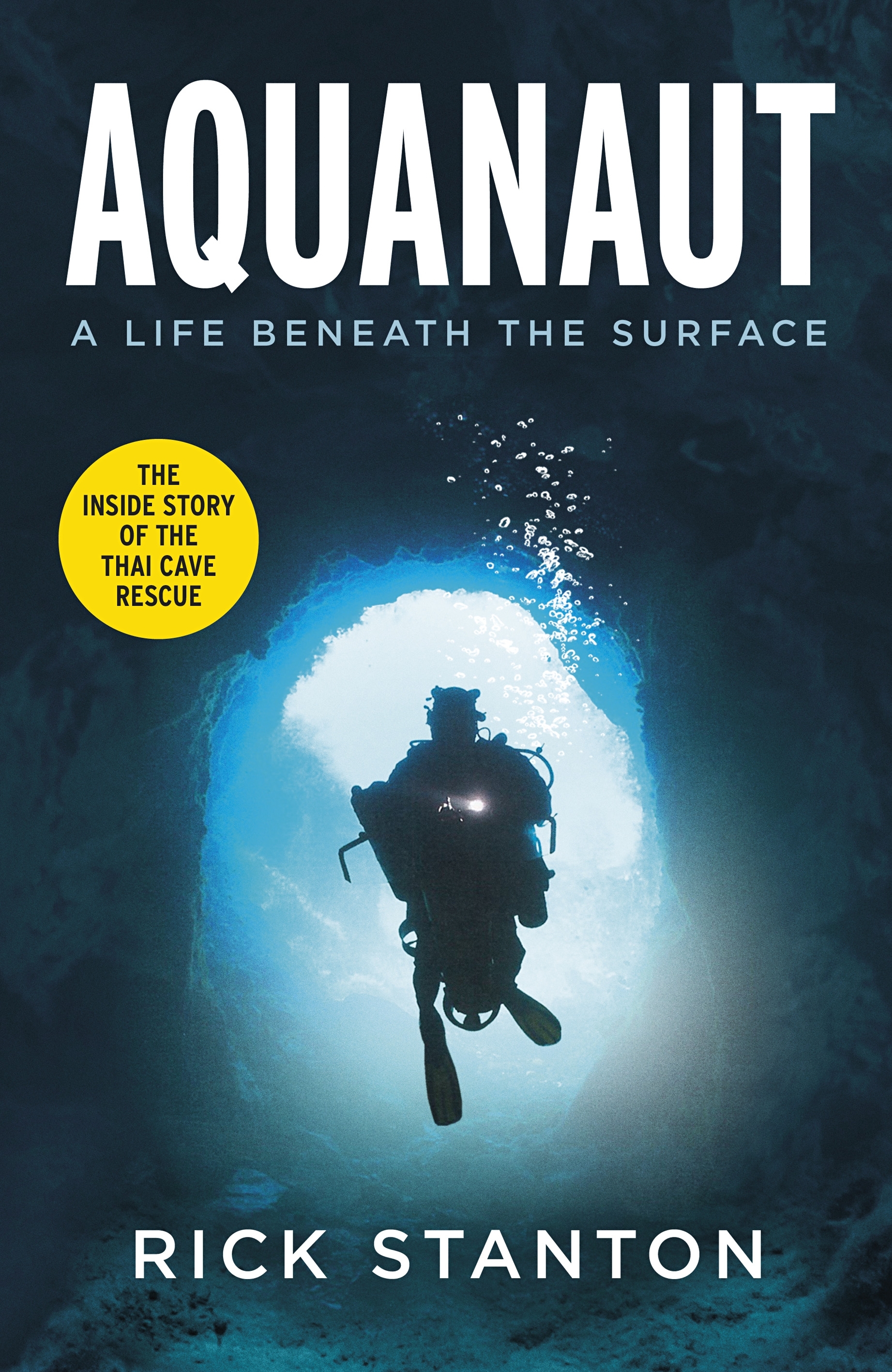
Aquanaut by Rick Stanton, reviewed by Imogen Clement.
Finished the whole book in a
day I couldn’t look up from the page. Fucking awesome. Also a good
advertisement to convince me to never ever ever cave dive lol.
Aquanaut is available from Wildplaces Publishing, Thanks to the generosity of Michael Joseph publishers, a copy of Aquanaut has been lodged in the club library.
|
|
DON'T MAKE US CRY, READ TO THE END AND LET US KNOW!

If you're reading this, you're nearly there, so click the link
and let us know that you survived another newsletter and massage the
fragile egos of your hard-working editors. remember, if you don't, Zac
has threatened to fill the newsletter with computer science instead of
caving!
So, who won last time? In first place we have..... drum roll....
- Kept me reading when I should have already started work. Again! (Chris Howes) (The winner!)
- This was a fascinating newsletter! I loved the trip writeups,
can’t wait to get Rick’s book, and Zac’s story of the hero’s journey was
really interesting! (Jan Walker)
- Thanks Linda, & authors...what a super breakfast read :)
nice to know the Hunters’ Lodge has gained some more thirsty post cave
customers! (John Williams aka Tangent)
- I read to the end! Always do but can't bothered to let everyone
know, apart from now when I've been told me to! (Merryn Matthews)
- lots of good stuff! particularly enjoyed the little history section. Bring back pipes ! (Imogen Clement)
- Good to hear everyone’s getting caving again, thanks for the newsletter! (Charlie Harding)
- I read to the end! (Eve Gilmore)
- Another entertaining newsletter - many thanks for keeping me in
touch with UBSS doings far over the horizon from the Flatlands in East
Anglia. (Tim Atkinson)
- A record for me, getting to the end in the same month that
the newsletter drops into my in box - great photos got me to the point
of wanting to go caving again, then Zac's article put paid to that !
Must say that I had difficulty in convincing my daughter that the
photo of RR (my first SRT trip courtesy of Mr Paganuzzi) was from
the Mendips. (Steve Hobbs) [Editors' note: Dan yr Ogof, off-putting?
Surely some mistake! Or is Professor/Dr/Mr Hobbs implying that he's
never been on a Hero's Journey?]
So, who read to the end this time?
THE END
|
|
|
|